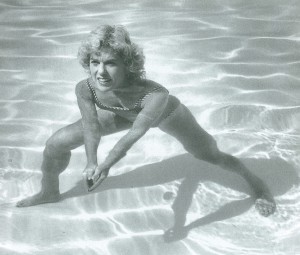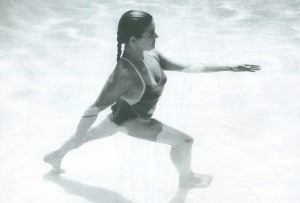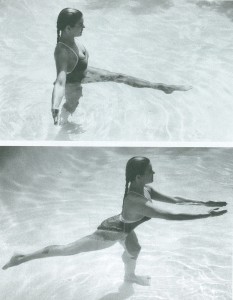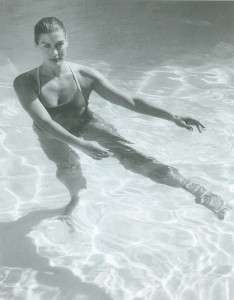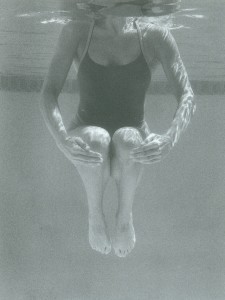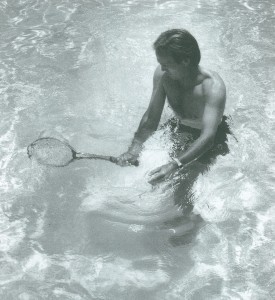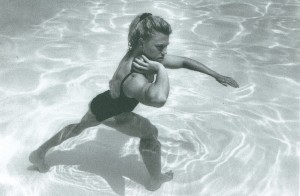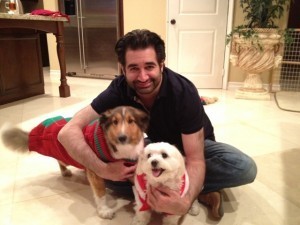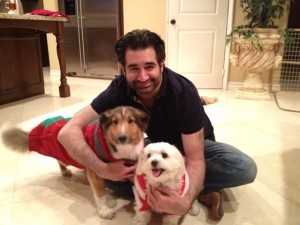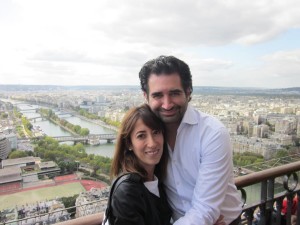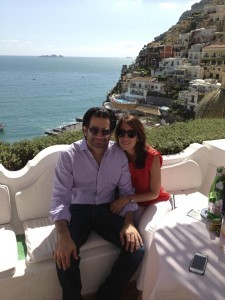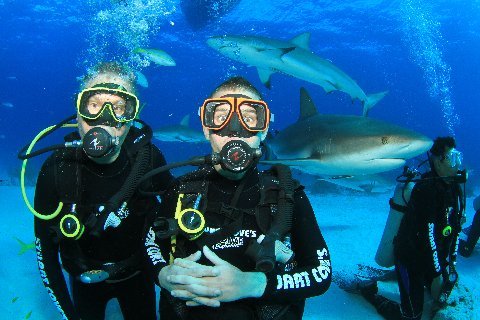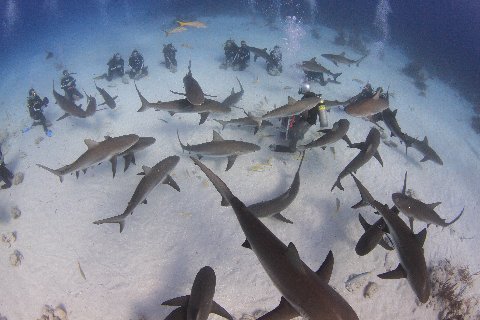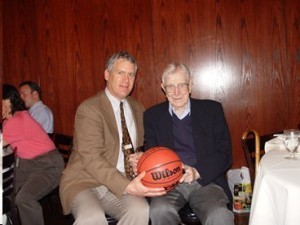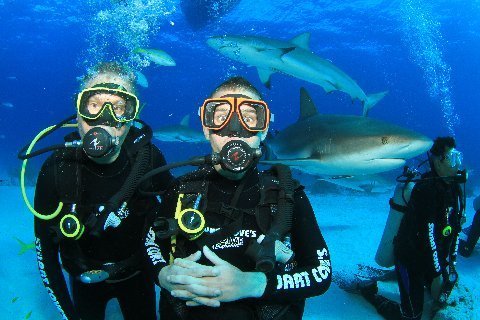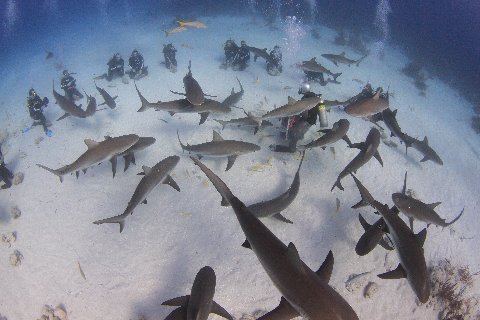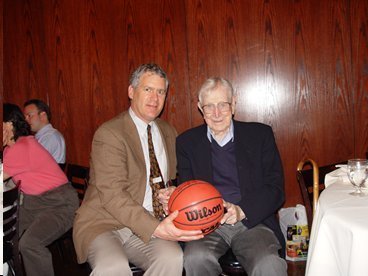Lynda Huey's Blog, page 3
September 24, 2014
Aquatic Therapy Symposium in Brazil
The three previous times I went to South America, I changed planes or spent the night in Miami. This time I was pleased to see there was a 12-hour, non-stop flight from Los Angeles to Sao Paulo. I took it. Physical therapist Douglas Gil met me at the airport and as we drove into town, he explained with great pride that the regulatory body of physical therapy in Brazil had just the previous week estblished a new ruling that anyone who practiced aquatic therapy would first have to pass an exam and become a certified aquatic therapist. Douglas had been part of the group lobbying to make this change, so he was very pleased with that outcome.
The next day was gorgeous, and Douglas took me to Sao Paulo Park, the equivalent of New York’s Central park, albeit a bit smaller with very different vegetation. I was stunned by the immensity of the city. It was as though someone took a dozen Manhattans and jammed them next to one other – it was high rises and high rises as far as we could see and as far as we drove. The park was lovely with black swans in the lake and a mesmerizing fountain that kept changing its configuration of water sprays. I watched and took photos for nearly ten minutes and never saw the same thing twice.
Douglas was an incredibly gracious host throughout my visit. He had told me of his unique pool that curved along the outside of the city’s soccer stadium. But I hadn’t realized what an incredible jewel his Instituto Vita would be until I saw it for myself. What luxury! It reminded me of the old days of physical therapy when we were well paid by insurance companies and we could easily be profitable, which meant we could have lots of “extras.” They handed out plush towels and bathrobes to all those going into the pool. Lucky me, I was one of them. I went into his 93-degree pool for my own workout. The slippery tile on the bottom of the pool surprised me, but I would see throughout my trip that every single pool I visited in Brazil had a slippery tile bottom surface, unlike the plaster bottoms here in the U.S., which provide good traction. Also like the other pools I visited, they had an excess of overly shallow water that wasn’t even up to waist level, which wasted valuable space in the pool and was would go unused except by small children. (For most plyometric exercises, we make sure everyone is working in mid-chest-deep water.) The last 10-15 feet and the end of the pool was deep, which made me happy. I’ve learned that over half of the benefit of pool therapy comes from taking the weight off the knees, hips, back, legs, and feet so they can heal while fitness is gained or maintained.
Douglas took me to lunch at the nearby café, which must be fantastic for all those who work there. Great, fast, buffet with lots of variety. I tried quail eggs for the first time and loved them. Although I can fumble along in French and Italian, I don’t know much Portuguese, and although I tried, not much of it would stick. So Douglas connected me with doctors and therapists who spoke English so that I could chat with them. I learned the history of the clinic. Sixteen of the top orthopedic doctors in Sao Paulo got together and decided to create the best clinic ever. Douglas and one of the surgeons had known each other for years. When the doctor called Douglas and told him the idea, Douglas asked if there was going to be a pool. The doctor said no, to which Douglas replied, “Then it won’t be the best clinic ever!” They quickly altered the plans and squeezed in a pool around the track as seen in the photos. Douglas is in charge of the physical therapy and the doctors and therapists work in the same clinic taking great care of patients who might be trying to prevent orthopedic surgery, be preparing for surgery, or recovering from surgery. They afford the luxuries of this first-class facility by having mostly private paying patients, ones who pay for their care from their own pockets.
Douglas hadn’t intended to work that day, but when his patients started arriving and seeing him there, he began talking with them, and before long he was wearing his white coat and treating his patients. One of his female patients was a champion kick boxer. Douglas, as a gold medalist in judo at the 1987 Pan American Games, could help get her ready for competition. But over the weekend, she had broken her wrist and was there on a table wearing a cast.
The next day, Wednesday, we flew to Florianopolis, an island on Brazil’s East Coast. Physical therapist Romulo Brito met us there and took us to lunch. He and Douglas went over details of the Aquatic Therapy Symposium they had organized that would start on Friday at a local university. It was billed as the First International Aquatic Therapy Symposium. I think I was the international part.
Thursday was a sightseeing day with Lisianne Fabris, one of the many beautiful women of “Floripa” as the locals call it. It was astonishing to see so many stunning beauties everywhere you looked. Lisianne and I had planned to go body boarding that day. I had packed my wetsuit and fins. But rainy, cold weather stopped us. Instead Lisianne showed us her island. There’s a gorgeous fresh-water lagoon and overlook.

View from my hotel window. Rainy most mornings.

Lynda and Lisianne Fabris overlooking the large lagoon on Florianopolis.
We drove to the beach where we would have caught some waves if conditions had been better. Lovely, but nobody out surfing.

Joaquina Beach, Florianopolis
We drove around the island and stopped for lunch.
Even though I’d only met Lisianne that morning, I felt like I was on vacation with a long-time friend. She and Douglas and I crossed to the other side of the island where they wanted to show me the oyster farms. Douglas asked if I’d heard of Nostradamas. Of course! Well, he wanted to show me Osterdamas. “If you love oysters, this is the place you have to eat.” They showed me the oyster farms just off shore and said that every morning planes left that area with oysters for all of Brazil. Since he loved oysters, we stopped for him to eat some. Lisianne and I passed on the oysters and had dessert instead.
Friday came and the Symposium opened. All of the work by Lisianne, Romulo, Douglas, and others came to fruition. Dignitaries from the university gathered and gave speeches. Romulo and Lisianne turned the focus toward aquatic therapy, and then I gave the Grand Opening Address to 150 attendees. I used Douglas as my translator, but I could tell a few women in the front rows could speak English, because they would nod and smile as I spoke rather than having to wait to hear the translation.
I gave some background of what we learned from working with many of the world’s best athletes in water in the 1980s and 1990s – brief stories of Florence Griffith Joyner, Wilt Chamberlain, Willie Banks, Mike Powell, and Bo Jackson. Then I addressed the topic of preventing knee and hip surgery. In Brazil, the therapists hadn’t yet heard of the Finnish research study that showed that meniscus surgery may help no more than a fake operation. Physical therapy was the suggested alternative rather than having arthroscopic knee surgery. They had also not heard of the recent American study that concluded that over one-third of all total knee replacements done in America in the last five years were inappropriate based on patient surveys of their pain levels and ability to function. I taught them about deep-water prevention, prehab, or rehab for knees and hips – how we always hope to prevent the surgery, but if the problem doesn’t resolve, our work may turn into prehab for surgery. And in other cases, where patients come to us for the first time after they’ve already had surgery, we do the rehab starting in deep water where there is no weight bearing.
Later that evening, it was time to go to the pool. We used the diving well and the CompletePT flotation belts I brought with me to demonstrate deep-water interval training, deep-water exercises, and kick training.
Then we changed pools to have shallow, warmer water for the running and jumping (plyometric) exercises.
The next day, the seminar speakers would all be talking in Portuguese, so I took the day off and relaxed, walking along the water front, eating spectacular peanut butter ice cream, buying watermelon and papayas to eat throughout the day. The closing dinner was a traveling circus as we walked from one place to another trying to find somewhere that could accommodate 40 people for a last-minute dinner around 10pm. Yes, Brazil is like eating in Italy or Greece – very late at night.
We finished an all-you-can-eat sushi dinner around 1 am.
On Sunday we went to the airport to fly back to Sao Paulo. About six of us were on the same flight, and we waited together by the gate. A TV news program was about 20 yards away above everyone’s heads. I was facing the TV and Douglas had his back to it. Suddenly on the screen I saw a beautiful young woman in a wheelchair with a head rest. She was on the sidelines of a soccer game and a player came running over to her to kiss her. “Douglas!” I interrupted. “Is that the patient you were telling me about?” Douglas had told me the story of Lais Souza who was a two-time Olympic gymnast for Brazil. He had treated her for a torn labrum in her hip as well as after elbow and knee surgeries.
Since she was in her mid-twenties and old for a gymnast, she switched sports and made the 2012 Brazilian Olympic team in Freestyle Skiing (trick jumping, something fairly easy for a skilled gymnast). She had never seen snow until just about 6 months before she was to compete in the Winter Olympics. She was training in Park City, Utah, when she crashed into a tree and sustained severe traumatic injuries that left her unable to use her arms or legs. She was moved from Park City to Miami to obtain the best care for the spinal cord injury. Douglas flew there to help her in the pool.
Douglas ran over to the TV monitor and watched the rest of the broadcast. Yes, it was his patient Lais Souza as seen in the photos above.
Monday was my final day in Brazil before taking a red-eye flight back to L.A. Rosane Caetano spoke excellent English and gave me a tour of SAGA, her aquatic therapy clinic, which has 3 pools. I taught Rosane’s staff the same deep-water intervals, deep-water exercises, and kicking series I had taught in Floripa.

SAGA physical therapist (left) and young Muscular Dystrophy patient (right)
Rosane arranged for me to visit the hospital where she had worked previously, AACD, a hospital for disabled children primarily, but where adults were also being treated with physical therapy, aquatic therapy, occupational therapy, and many other treatments. We were allowed to observe a 13-year-old girl with cerebral palsy as she was taken through a LOKOMAT treatment – an amazing high-tech machine with body harness and a treadmill plus mechanical legs that force the patient’s own legs to move in time to a rhythmic, mechanical cadence while the patient watches a virtual walk through the park for biofeedback.
I got to observe rush hour in Sao Paulo first hand as Douglas drove me to the airport. It was very similar to rush hour in L.A. We got there right on time and I relaxed knowing that since I was on American Airlines, I would be back in the USA the moment I stepped onto the plane.
Lynda Huey, M.S., founder of CompletePT Pool & Land Physical Therapy and Huey’s Athletic Network, was a member of Wilt’s Wonder Women. She has cross trained many of the world’s best athletes in water from track and field, basketball, baseball, tennis, ice hockey and other sports. Lynda, an international speaker, is the author of four books on water exercise and water rehabilitation. She has licensed her pool protocols to major health care providers, and her training methods will soon be available online at LyndaHuey.com.
Brazil’s First Aquatic Therapy Symposium
The three previous times I went to South America, I changed planes or spent the night in Miami. This time I was pleased to see there was a 12-hour, non-stop flight from Los Angeles to Sao Paulo. I took it. Physical therapist Douglas Gil met me at the airport and as we drove into town, he explained with great pride that the regulatory body of physical therapy in Brazil had just the previous week estblished a new ruling that anyone who practiced aquatic therapy would first have to pass an exam and become a certified aquatic therapist. Douglas had been part of the group lobbying to make this change, so he was very pleased with that outcome.
The next day was gorgeous, and Douglas took me to Sao Paulo Park, the equivalent of New York’s Central park, albeit a bit smaller with very different vegetation. I was stunned by the immensity of the city. It was as though someone took a dozen Manhattans and jammed them next to one other – it was high rises and high rises as far as we could see and as far as we drove. The park was lovely with black swans in the lake and a mesmerizing fountain that kept changing its configuration of water sprays. I watched and took photos for nearly ten minutes and never saw the same thing twice.
Douglas was an incredibly gracious host throughout my visit. He had told me of his unique pool that curved along the outside of the city’s soccer stadium. But I hadn’t realized what an incredible jewel his Instituto Vita would be until I saw it for myself. What luxury! It reminded me of the old days of physical therapy when we were well paid by insurance companies and we could easily be profitable, which meant we could have lots of “extras.” They handed out plush towels and bathrobes to all those going into the pool. Lucky me, I was one of them. I went into his 93-degree pool for my own workout. The slippery tile on the bottom of the pool surprised me, but I would see throughout my trip that every single pool I visited in Brazil had a slippery tile bottom surface, unlike the plaster bottoms here in the U.S., which provide good traction. Also like the other pools I visited, they had an excess of overly shallow water that wasn’t even up to waist level, which wasted valuable space in the pool and was would go unused except by small children. (For most plyometric exercises, we make sure everyone is working in mid-chest-deep water.) The last 10-15 feet and the end of the pool was deep, which made me happy. I’ve learned that over half of the benefit of pool therapy comes from taking the weight off the knees, hips, back, legs, and feet so they can heal while fitness is gained or maintained.
Douglas took me to lunch at the nearby café, which must be fantastic for all those who work there. Great, fast, buffet with lots of variety. I tried quail eggs for the first time and loved them. Although I can fumble along in French and Italian, I don’t know much Portuguese, and although I tried, not much of it would stick. So Douglas connected me with doctors and therapists who spoke English so that I could chat with them. I learned the history of the clinic. Sixteen of the top orthopedic doctors in Sao Paulo got together and decided to create the best clinic ever. Douglas and one of the surgeons had known each other for years. When the doctor called Douglas and told him the idea, Douglas asked if there was going to be a pool. The doctor said no, to which Douglas replied, “Then it won’t be the best clinic ever!” They quickly altered the plans and squeezed in a pool around the track as seen in the photos. Douglas is in charge of the physical therapy and the doctors and therapists work in the same clinic taking great care of patients who might be trying to prevent orthopedic surgery, be preparing for surgery, or recovering from surgery. They afford the luxuries of this first-class facility by having mostly private paying patients, ones who pay for their care from their own pockets.
Douglas hadn’t intended to work that day, but when his patients started arriving and seeing him there, he began talking with them, and before long he was wearing his white coat and treating his patients. One of his female patients was a champion kick boxer. Douglas, as a gold medalist in judo at the 1987 Pan American Games, could help get her ready for competition. But over the weekend, she had broken her wrist and was there on a table wearing a cast.
The next day, Wednesday, we flew to Florianopolis, an island on Brazil’s East Coast. Physical therapist Romulo Brito met us there and took us to lunch. He and Douglas went over details of the Aquatic Therapy Symposium they had organized that would start on Friday at a local university. It was billed as the First International Aquatic Therapy Symposium. I think I was the international part.
Thursday was a sightseeing day with Lisianne Fabris, one of the many beautiful women of “Floripa” as the locals call it. It was astonishing to see so many stunning beauties everywhere you looked. Lisianne and I had planned to go body boarding that day. I had packed my wetsuit and fins. But rainy, cold weather stopped us. Instead Lisianne showed us her island. There’s a gorgeous fresh-water lagoon and overlook.

View from my hotel window. Rainy most mornings.

Lynda and Lisianne Fabris overlooking the large lagoon on Florianopolis.
We drove to the beach where we would have caught some waves if conditions had been better. Lovely, but nobody out surfing.

Joaquina Beach, Florianopolis
We drove around the island and stopped for lunch.
Even though I’d only met Lisianne that morning, I felt like I was on vacation with a long-time friend. She and Douglas and I crossed to the other side of the island where they wanted to show me the oyster farms. Douglas asked if I’d heard of Nostradamas. Of course! Well, he wanted to show me Osterdamas. “If you love oysters, this is the place you have to eat.” They showed me the oyster farms just off shore and said that every morning planes left that area with oysters for all of Brazil. Since he loved oysters, we stopped for him to eat some. Lisianne and I passed on the oysters and had dessert instead.
Friday came and the Symposium opened. All of the work by Lisianne, Romulo, Douglas, and others came to fruition. Dignitaries from the university gathered and gave speeches. Romulo and Lisianne turned the focus toward aquatic therapy, and then I gave the Grand Opening Address to 150 attendees. I used Douglas as my translator, but I could tell a few women in the front rows could speak English, because they would nod and smile as I spoke rather than having to wait to hear the translation.
I gave some background of what we learned from working with many of the world’s best athletes in water in the 1980s and 1990s – brief stories of Florence Griffith Joyner, Wilt Chamberlain, Willie Banks, Mike Powell, and Bo Jackson. Then I addressed the topic of preventing knee and hip surgery. In Brazil, the therapists hadn’t yet heard of the Finnish research study that showed that meniscus surgery may help no more than a fake operation. Physical therapy was the suggested alternative rather than having arthroscopic knee surgery. They had also not heard of the recent American study that concluded that over one-third of all total knee replacements done in America in the last five years were inappropriate based on patient surveys of their pain levels and ability to function. I taught them about deep-water prevention, prehab, or rehab for knees and hips – how we always hope to prevent the surgery, but if the problem doesn’t resolve, our work may turn into prehab for surgery. And in other cases, where patients come to us for the first time after they’ve already had surgery, we do the rehab starting in deep water where there is no weight bearing.
Later that evening, it was time to go to the pool. We used the diving well and the CompletePT flotation belts I brought with me to demonstrate deep-water interval training, deep-water exercises, and kick training.
Then we changed pools to have shallow, warmer water for the running and jumping (plyometric) exercises.
The next day, the seminar speakers would all be talking in Portuguese, so I took the day off and relaxed, walking along the water front, eating spectacular peanut butter ice cream, buying watermelon and papayas to eat throughout the day. The closing dinner was a traveling circus as we walked from one place to another trying to find somewhere that could accommodate 40 people for a last-minute dinner around 10pm. Yes, Brazil is like eating in Italy or Greece – very late at night.
We finished an all-you-can-eat sushi dinner around 1 am.
On Sunday we went to the airport to fly back to Sao Paulo. About six of us were on the same flight, and we waited together by the gate. A TV news program was about 20 yards away above everyone’s heads. I was facing the TV and Douglas had his back to it. Suddenly on the screen I saw a beautiful young woman in a wheelchair with a head rest. She was on the sidelines of a soccer game and a player came running over to her to kiss her. “Douglas!” I interrupted. “Is that the patient you were telling me about?” Douglas had told me the story of Lais Souza who was a two-time Olympic gymnast for Brazil. He had treated her for a torn labrum in her hip as well as after elbow and knee surgeries.
Since she was in her mid-twenties and old for a gymnast, she switched sports and made the 2012 Brazilian Olympic team in Freestyle Skiing (trick jumping, something fairly easy for a skilled gymnast). She had never seen snow until just about 6 months before she was to compete in the Winter Olympics. She was training in Park City, Utah, when she crashed into a tree and sustained severe traumatic injuries that left her unable to use her arms or legs. She was moved from Park City to Miami to obtain the best care for the spinal cord injury. Douglas flew there to help her in the pool.
Douglas ran over to the TV monitor and watched the rest of the broadcast. Yes, it was his patient Lais Souza as seen in the photos above.
Monday was my final day in Brazil before taking a red-eye flight back to L.A. Rosane Caetano spoke excellent English and gave me a tour of SAGA, her aquatic therapy clinic, which has 3 pools. I taught Rosane’s staff the same deep-water intervals, deep-water exercises, and kicking series I had taught in Floripa.

SAGA physical therapist (left) and young Muscular Dystrophy patient (right)
Rosane arranged for me to visit the hospital where she had worked previously, AACD, a hospital for disabled children primarily, but where adults were also being treated with physical therapy, aquatic therapy, occupational therapy, and many other treatments. We were allowed to observe a 13-year-old girl with cerebral palsy as she was taken through a LOKOMAT treatment – an amazing high-tech machine with body harness and a treadmill plus mechanical legs that force the patient’s own legs to move in time to a rhythmic, mechanical cadence while the patient watches a virtual walk through the park for biofeedback.
I got to observe rush hour in Sao Paulo first hand as Douglas drove me to the airport. It was very similar to rush hour in L.A. We got there right on time and I relaxed knowing that since I was on American Airlines, I would be back in the USA the moment I stepped onto the plane.
Lynda Huey, M.S., founder of CompletePT Pool & Land Physical Therapy and Huey’s Athletic Network, was a member of Wilt’s Wonder Women. She has cross trained many of the world’s best athletes in water from track and field, basketball, baseball, tennis, ice hockey and other sports. Lynda, an international speaker, is the author of four books on water exercise and water rehabilitation. She has licensed her pool protocols to major health care providers, and her training methods will soon be available online at LyndaHuey.com.
August 18, 2014
Wilt’s Wonder Women Track Club
I had known Wilt Chamberlain for nearly three years when I introduced him to track coach Tracy Sundlun. That introduction took place at UCLA’s Drake Stadium, the center of the track world in Southern California. It was June, 1974, and it was the California State AAU Championships for Women’s Track and Field.

Left to right – Lynda Huey, Wilt, Patty Van Wolvelaere
Tracy had coached our San Luis Obispo Track Club the 1972-73 school year when we had both lived there, then he had taken a job with the La Jolla Track Club near San Diego. Tracy knew I’d met Wilt a few years earlier and wanted to meet him, too. Since Wilt loved track and field, especially women’s track and field, it seemed natural to make the connection at a track meet. My best friend Patty Van Wolvelaere was America’s top hurdler at the time. Patty, Wilt, and I had spent a lot of time together, so when Tracy reminded us again that he wanted to meet Wilt, Patty Van and I brought him with us to the state meet.
“Wilt had been a huge track buff for years,” said Tracy. “We clicked immediately and in a few weeks, right after the nationals, we were off on a two-week motor home trip through the Pacific Northwest. Patty Van popped in and out a few times while visiting family in Seattle. One time Wilt was asleep in the back of the motor home and I was driving. I had no idea where we were. We were waiting in a line at a drawbridge in East Puckyboo somewhere. There’s a knock at the door. Someone said, ‘We heard Wilt is here. Can we meet him?’
That’s what it was always like traveling with Wilt: The Wiltie hotline spread the news like wildfire and people flocked toward him for a chance to see or meet him.
“During those two weeks, I was eating with him mouthful for mouthful, “said Tracy, “and I gained 23 pounds. At the end of the trip, Wilt bet me that I couldn’t lose that weight in the same two weeks I had gained it. Whoever won the bet would pay for a meal at any restaurant of the winner’s choosing.”
Tracy made the weigh-in and told Wilt he wanted to eat at their favorite restaurant in Vancouver. “That’s not fair,” Wilt complained, but laughed when Tracy said, “that’s where I gained it, and you didn’t say it had to be any specific place.” Back in Vancouver, at Simon Frazier University, Wilt and Tracy were shooting around in the gym. Wilt was nailing it, hitting only the net from all over, even at half court. “What’s your problem with the foul line?” Tracy asked him. (Wilt was notorious for missing free shots.)
Wilt’s Wonder Women Track Club started after that. Wilt was retiring from the NBA and even though Sport Illustrated said said they didn’t pay anyone for interviews, they came through with $5,000 for Wilt to announce his retirement in their magazine.
“That started the club,” said Tracy. The La Jolla Track Club became Wilt’s Wonder Women. The photographer from SI showed up to take some casual shots of the new team as part of their work on the article.

Wilt, Janice Wiser Pope, Sherry Ball Garcia, Toni Griffin, Cindy Gilbert Snow, Tracy Sundlun
Wilt’s Wonder Women Track Club was a major player in women’s track and field on both the individual and team level. The team did well in all the categories: Youth, Junior, and Senior, and in all events, with several athletes winning national championships and making their national teams. There were a lot of young “age groupers” running around at practices, and every once in a while Wilt would show up unexpectedly to rake the long jump pit or simply cheer them on and offer some friendly sports advice. He may have been a basketball play, but he loved track and field.

Left to right – Lynda Huey braiding Sherry Ball’s hair, Wilt, Rhonda Whitlow on the UC Irvine high jump pit
“He changed all these kids’ lives,” said Tracy. “I can say that without any hesitation because of who he was and what he told them and how he carried himself and the affection he showed to them in a genuine, caring way. He was always looking out for their best interests. They all knew he was a big deal, but they didn’t treat him like a big deal. He sincerely cared about each one of them and everything he did was purely natural and from the heart. They were all very lucky to have this marvelous, unique father figure.”

Tracy Sundlun
While many of the athletes were young girls up to high school age, there were a few of us old enough to hang out socially with Wilt. We would go dancing at the Jabberwocky night club in San Diego or other places Wilt liked in L.A. None of us were really drinkers — we just enjoyed dancing and laughing with this larger than life man who knew how to have fun.
On race days, we showed up fully present at the starting line. At 27, I was the oldest female on Wilt’s team, and during my college days, no one had suggested that sprinters do any distance training. But Tracy entered me in my first 1.75 mile cross country race in 1974. I had never raced longer than 220 yards, so I went out much faster than an experienced runner at that distance would have. That meant I faced a huge hurt for a very long time as I refused to slow down. That race made a good last story in my autobiography, A Running Start: An Athlete, A Woman. And it had a great last photo. After three years of bantering with Wilt, that was the day that I felt I had finally earned his respect.

Wilt watches as I come in third in my first cross-country race. We hadn’t yet received our Wilt’s Wonder Women uniforms.
Elite athletes sometimes contacted Tracy to join the team. Sprinter Cathy Lawson was a world class sprinter and would move to La Jolla from New England if Tracy could provide chiropractic care for her. Tracy was directed to learned of John Thie, D.C. in Pasadena by Cathy’s chiropractor in Massachusetts, but when he called, learned that Dr. Thie was on vacation for two weeks. LeRoy Perry, D.C. was Dr. Thie’s partner and said he could do everything Dr. Thie did. With much skepticism, Tracy drove Cathy to Pasadena and Cathy liked what he did for her. Before long, Tracy was regularly taking the girls in a motor home to Pasadena after practice. They invited Dr. Perry to some of their meets, but he wasn’t allowed in the training area by “the real doctors,” so he set up a table underneath the stands and the treated the athletes there.
Wilt’s Wonder Women and Dr. Perry made their mark on the track world when Patty Van Wolvelaere and Tracy organized a track and field clinic at Mira Costa College in 1974. Their friends were the biggest names in the sport and over 500 athletes and coaches came to the clinic. At one point during the clinic, everyone was in the gym. Dr. Perry had Al Feuerbach who was the world record holder in the shot put lying on a table. After some manipulations and acupressure, Al couldn’t lift his arm and he couldn’t do a sit up. Then LeRoy undid his work and Al could move normally again. It seemed to those watching that Dr. Perry had performed some kind of magic. LeRoy became the center of chiropractic in T&F.

LeRoy Perry, D.C., Wilt, Tracy Sundlun at the clinic at Mira Costa College
“Wilt never got the credit he deserved in supporting women’s athletics,” said Tracy. “Here was the world’s most famous, most visible athlete of the time promoting women’s athletics right around the time of Title IX, showing up at women’s track meets. He was saying, ‘Hey World, wake up – these women are great athletes.’ He put them front and center. It was very good for the sport as a whole, because he would go to track meets all over the world. Wilt’s visibility contributed to bringing the women into the big time.”
Women’s track meets had been held separately from the men’s meets. But the media was hungry for Wilt, so meet promoters began thinking differently about including women in their meets since they knew it could mean Wilt would show up. He might sit in the press box or to help measure the long jump or the javelin. That was a story all in itself. Wiltie greatly enjoyed being around the sport he loved, and since he was focusing the powerful light of his presence on women’s track, it helped change the sport. Starting in 1976, the sports reporters wrote about both men and women who were competing together for the first time at the Olympic Trials in Eugene, Oregon.
Tracy Sundlun coached Wilt’s Wonder Women for two seasons. When he left to coach at USC, the team returned to its former name of La Jolla Track Club. Wilt maintained his relationship with the sport, attending the 1976 Montreal Olympic Games, the World Cup of T&F in Montreal in 1979, and the first World Athletics Championships in Helsinki in 1983. Also in the 1980s, he started Wilt’s Athletic Club with UCLA track coach Bobby Kersee. Team members were the top track athletes in the world: Jackie Joyner-Kersee, Florence Griffith Joyner, Andre Phillips, Gail Devers, Valerie Brisco, Jeannette Bolden, and others.
Years later, Wilt found a way to merge two of his loves, music and running. He had owned a night club in Harlem during the years he played for the Philadelphia Warriors. He loved music as much as he loved athletics. So when Tracy Sundlun established the Rock ‘n Roll Marathon in San Diego in 1998, Wilt became involved as a celebrity founder.
At the pasta dinner the night before that first race, Wilt spoke, telling of his affinity for cross country when he had been at Overbrook High School. Every Fall he would run cross country only to be crushed by faster distance runners. He told the crowd that night that when basketball season started, and he got to see those guys and those teams again, it had been purely for revenge as he ran up the score against them.

Wilt was a celebrity-founder of the Rock ‘n Roll Marathon with Tracy Sundlun.
August 21st would have been Wilt’s 78th birthday. Each year, I enjoy a walk down memory lane by writing the blog about some aspect of the 28 years I enjoyed his company.
Lynda Huey, M.S., founder of CompletePT Pool & Land Physical Therapy and Huey’s Athletic Network, was a member of Wilt’s Wonder Women. She has cross trained many of the world’s best athletes in water from track and field, basketball, baseball, tennis, ice hockey and other sports. Lynda, an international speaker, is the author of four books on water exercise and water rehabilitation. She has licensed her pool protocols to major health care providers, and her training methods will soon be available online at LyndaHuey.com.
Wilt’s Wonder Women Track Club
I had known Wilt Chamberlain for nearly three years when I introduced him to track coach Tracy Sundlun. That introduction took place at UCLA’s Drake Stadium, the center of the track world in Southern California. It was June, 1974, and it was the California State Championships of Women’s Track and Field.

Left to right – Lynda Huey, Wilt, Patty Van Wolvelaere
Tracy had coached our San Louis Obispo Track Club the 1972-73 school year when we had both lived there, then he had taken a job with the La Jolla Track Club near San Diego. Tracy knew I’d met Wilt a few year earlier and wanted to meet him, too. Since Wilt loved track and field, especially women’s track and field, it seemed natural to make the connection at a track meet. My roommate Patty Van Wolvelaere was America’s top hurdler at the time. Patty, Wilt, and I had spent a lot of time together, so when Tracy reminded us again that he wanted to meet Wilt, Patty Van and I brought him with us to the state meet.
“Wilt had been a huge track buff for years,” said Tracy. “We clicked immediately and in a few weeks, right after the nationals, we were off on a two-week motor home trip through the Pacific Northwest. Patty Van popped in and out a few times while visiting family in Seattle. One time Wilt was asleep in the back of the motor home and I was driving. I had no idea where we were. We were waiting in a line at a drawbridge in East Puckyboo somewhere. There’s a knock at the door. Someone said, ‘We heard Wilt is here. Can we meet him?’
That’s what it was always like traveling with Wilt: The Wiltie hotline spread the news like wildfire and people flocked toward him for a chance to see or meet him.
“During those two weeks, I was eating with him mouthful for mouthful, “said Tracy, “and I gained 23 pounds. At the end of the trip, Wilt bet me that I couldn’t lose that weight in the same two weeks I had gained it. Whoever won the bet would pay for a meal at any restaurant of the winner’s choosing.”
Tracy made the weigh-in and told Wilt he wanted to eat at their favorite restaurant in Vancouver. “That’s not fair,” Wilt complained, but laughed when Tracy said, “that’s where I gained it, and you didn’t say it had to be any specific place.” Back in Vancouver, at Frazier University, Wilt and Tracy were shooting around in the gym. Wilt was nailing it, hitting only the net from all over, even at half court. “What’s your problem with the foul line?” Tracy asked him. (Wilt was notorious for missing free shots.)
Wilt’s Wonder Women Track Club started after that. Wilt was retiring from the NBA and even though Sport Illustrated had said “no” to paying him for an exclusive interview, they came through with $5,000 for Wilt to announce his retirement in their magazine.
“That started the club,” said Tracy. The La Jolla Track Club became Wilt’s Wonder Women. The photographer from SI showed up to take some casual shots of the new team.

Wilt, Janice Wiser Pope, Sherry Ball Garcia, Toni Griffin, Cindy Gilbert Snow, Tracy Sundlun
Wilt’s Wonder Women Track Club was a major player in women’s track and field on both the individual and team level. The team did well in all the categories: Youth, Junior, and Senior. There were a lot of young “age groupers” running around at practices, and every once in a while Wilt would show up unexpectedly to rake the long jump it or simply cheer them on and offer some friendly sports advice. He may have been a basketball play, but he loved track and field.

Left to right – Lynda Huey braiding Sherry Ball’s hair, Wilt, Rhonda Whitlow on the UC Irvine high jump pit
“He changed all these kids’ lives,” said Tracy. “I can say that without any hesitation because of who he was and what he told them and how he carried himself and the affection he showed to them in a genuine, caring way. He was always looking out for their best interests. They all knew he was a big deal, but they didn’t treat him like a big deal. He sincerely cared about each one of them and everything he did was purely natural and from the heart. They were all very lucky to have this marvelous, unique father figure.”
While many of the athletes were young girls up to high school age, there were a few of us old enough to hang out socially with Wilt. We would go dancing at the Jabberwocky night club in San Diego or other places Wilt liked in L.A. None of us were really drinkers — we just enjoyed dancing and laughing with this larger than life man who knew how to have fun.
On race days, we showed up fully present at the starting line. At 27, I was the oldest female on Wilt’s team, and during my college days, no one had suggested that sprinters do any distance training. But Tracy entered me in my first 1.75 mile cross country race in 1974. I had never raced longer than 220 yards, so I went out much faster than an experienced runner at that distance would have. That meant I faced a huge hurt for a very long time as I refused to slow down. That race made a good last story in my autobiography, A Running Start: An Athlete, A Woman. And it had a great last photo. After three years of bantering with Wilt, that was the day that I felt I had finally earned his respect.
Elite athletes sometimes contacted Tracy to join the team. Sprinter Cathy Lawson was a world class sprinter and would move to La Jolla from New Hampshire if Tracy could provide chiropractic care for her. After some research, Tracy learned of John Thie, D.C. in Pasadena, but when he called, learned that Dr. Thie was on vacation for two weeks. LeRoy Perry, D.C. was training with Dr. Thie and said he could do everything Dr. Thie did. Tracy and Cathy drove to Pasadena and Cathy liked what he did for her. Before long, Tracy was regularly taking the girls in a motor home to Pasadena after practice. They invited Dr. Perry to some of their meets, but he wasn’t allowed in the training area, so he set up a table underneath the stands and the treated the athletes there.
Wilt’s track club and Dr. Perry made their mark on the track world when Patty Van Wolvelaere organized a track and field clinic at Mira Costa College in 1974. Patty’s friends were the biggest names in the sport that drew over 500 people to the clinic. At one point during the clinic, everyone was in the gym. Dr. Perry had Al Feuerbach who was the world record holder in the shot put lying on a table. After some manipulations and acupressure, Al couldn’t lift his arm and he couldn’t do a sit up. Then LeRoy undid his work and Al could move normally again. It seemed to those watching that Dr. Perry had performed some kind of magic. LeRoy became the center of chiropractic in T&F.

LeRoy Perry, D.C., Wilt, Tracy Sundlun at the clinic at Mira Costa College
“Wilt never got the credit he deserved in supporting women’s athletics,” said Tracy. “Here was the world’s most famous, most visible athlete of the time promoting women’s athletics right around the time of Title IX, showing up at women’s track meets. He was saying, ‘Hey World, wake up – these women are great athletes.’ He put them front and center. It was very good for the sport as a whole, because he would go to track meets all over the world. Wilt’s visibility contributed to bringing the women into the big time.”
Women’s track meets had been held separately from the men’s meets. But the media was hungry for Wilt, so meet promoters began thinking differently about including women in their meets since they knew it could mean Wilt would show up. He might sit in the press box or to help measure the long jump or the javelin. That was a story all in itself. Wiltie greatly enjoyed being around the sport he loved, and since he was focusing the powerful light of his presence on women’s track, it changed the sport. Starting in 1976, the sports reporters wrote about both men and women who were competing together for the first time at the Olympic Trials in Eugene, Oregon.
Tracy Sundlun coached Wilt’s Wonder Women for two seasons. When he left to coach at USC, the team returned to its former name of La Jolla Track Club. Wilt maintained his relationship with the sport, attending the 1976 Montreal Olympic Games, the World Cup of T&F in Montreal in 1979, and the first World Athletic Championships in Helsinki in 1983. Also in the 1980s, he started Wilt’s Athletic Club with UCLA track coach Bobby Kersee. Team members were the top track athletes in the world: Jackie Joyner-Kersee, Florence Griffith Joyner, Andre Phillips, Gail Devers, Valerie Brisco, Jeannette Bolden, and others.
Years later, Wilt found a way to merge two of his loves, music and running. He had owned a night club in Harlem during the years he played for the Philadelphia Warriors. He loved music as much as he loved athletics. So when Tracy Sundlun established the Rock ‘n Roll San Diego Marathon in 1998, Wilt became involved as a celebrity founder.
At the pasta dinner the night before that first race, Wilt spoke, telling of his affinity for cross country when he had been at Overbrook High School. Every Fall he would run cross country only to be crushed by faster distance runners. He told the crowd that night that when he had started playing basketball, it was purely for revenge.

Wilt was a celebrity-founder of the Rock ‘n Roll Marathon with Tracy Sundlun.
August 21st would have been Wilt’s 78th birthday. Each year, I enjoy a walk down memory lane by writing the blog about some aspect of the 28 years I enjoyed his company.
Lynda Huey, M.S., founder of CompletePT Pool & Land Physical Therapy and Huey’s Athletic Network, was a member of Wilt’s Wonder Women. She has cross trained many of the world’s best athletes in water from track and field, basketball, baseball, tennis, ice hockey and other sports. Lynda, an international speaker, is the author of four books on water exercise and water rehabilitation. She has licensed her pool protocols to major health care providers, and her training methods will soon be available online at LyndaHuey.com.
July 15, 2014
Cool in the Pool: Summertime Cross-Training
Cross-training for your sport in water becomes more and more appealing as the days get hotter during the summer. You can’t always train in the cool early-morning hours or evening, but you may live somewhere that there simply isn’t a cool time of morning or night. So on particularly hot days, stay cool in the pool while you increase your strength, power, aerobic and anaerobic fitness. You can train as gently or as hard as you wish in water while you improve your speed, flexibility, and sports skills. You can follow the lead of many legendary athletes.
When sport-specific Waterpower Workouts® were first offered to Olympic track and field athletes in 1983, they were considered an emergency tool only – a way to keep athletes active and sane during rehabilitation. But the biggest names of the sport in those days such as Joan Benoit and Mary Decker were returning to the track stronger and faster after their water workouts, and soon coaches began integrating pool sessions into their annual training programs. No longer did they wait for injury to strike to turn to water. By 1988 Waterpower Workouts were standard practice with Olympic medalists such as Florence Griffith Joyner, Al Joyner, Carol Lewis, Andrew Phillips, Kim Gallagher, Diane Dixon, Gail Devers, and Valerie Brisco. Their progressive coaches began cross-training these athletes in water whenever they sensed the athlete becoming vulnerable to injury. You can do the same.
Think of your sport. Whenever you move from one fitness level to the next – increasing speed, intensity, or volume – you run the greatest risk of injury. During these transition states you can run your fastest training intervals in the water; you can attempt your highest jumps using water as a landing cushion; and you can add your extra volume or even hours of aerobic work in the water. In this way, you prepare your body for the increasing demands of your sport without increasing the impact on your weight-bearing joints.
You can do these five moves for a sample cross-training workout without needing anything but a bathing suit! Just find a pool where you can stand in chest-deep water and do these plyometric (jumping) exercises that are sure to get your heart rate up.
1) Lunges: Bend your right knee and place your right foot a full stride ahead of your left foot. Put your left arm forward for counterbalance. Jump up and switch arm and leg positions so that left leg and right arm are now forward. Each right-left cycle is one repetition (rep). Do 30 reps.
2) Rocking Horse: Rock forward onto your left foot then back onto your right. Sweep both arms forward as you go forward and backward as you go back. After 30 reps with the left foot forward, switch legs and put the right foot forward for 30 more reps.
3) V-Kicks: Stand on your right leg and extend your straight left leg up and out to the side about 45 degrees. Bounce onto your left leg and lift your right leg up to the side keeping it straight. Sweep both arms toward the leg that lifts. Swinging the arms back and forth is one repetition. Do 30 reps.
4) Power Frog Jumps: Bounce with your feet together and your arms stretched out to your sides. Jump and left both knees toward your chest. At the same time sweep both arms forward to meet in front of you. Pull the arms back to their starting position as your feet return to the pool bottom. Jump immediately back up again without a bounce between Frog Jumps. Keep your chest lifted. 30 reps.
5) Running in Place: Begin running in place, simulating good form when running on land. Focus your eyes straight ahead on a focal point, which will help you keep your head and chest lifted. The knees lift to 90 degrees and the elbows pull straight back on each step. Now increase speed while maintaining good form. To do interval training, run fast, slow down to recover, then speed up again. Notice that the faster you run, the more you challenge your core muscles as well as your biceps and shoulder muscles.
If you need more work, do all five exercises again.
Want to see all these exercises in action? Here’s a TV news segment shot on July 6th at our pool.
And what about exercises that pertain to your sport? You can add them simply by copying a key technique you want to improve. For instance, racquetball players take old rackets into the pool to practice their swing. When performing this movement in the pool, the water’s resistance increases muscular strength for the swing while it also slows the movement, letting you have extra seconds per swing to feel your body parts in “freeze frame,” which in turn gives you more time for feedback to correct any flaws in the motion.
In water, you can teach your body to assume your sport’s key positions that are difficult to reach on land. For instance, it is hard to bend low enough when digging a volleyball, putting the shot, or hitting a kill shot in racquetball. You can practice the perfect form in the buoyancy of water until your body learns the “feel” of the correct position. You’ll be able to do more repetitions in water without over stressing your knees, and you’ll add grace to your movement.
Just remember that the more closely you duplicate the exact skill of your sport in the water, the better your work will transfer back to land.
At the end of your pool workout, you should find yourself refreshed, even on the hottest of days. If you pushed yourself, you should also feel totally satisfied that you got a powerful workout even though you don’t feel the muscular heaviness you might have felt on land. And while you’re feeling relaxed and hate to get out of the water, give yourself something might tend to overlook in your normal training routine – plenty of time to stretch before you leave the pool.
Lynda Huey, M.S., founder of CompletePT Pool & Land Physical Therapy and Huey’s Athletic Network, is a former athlete and coach whose own injuries led her into the water to find fitness and healing. She has cross trained many of the world’s best athletes in water from track and field, basketball, baseball, tennis, ice hockey and other sports. Lynda, an international speaker, is the author of four books on water exercise and water rehabilitation. Her training methods will soon be available online at LyndaHuey.com.
Cool in the Pool: Summertime Cross-Training
Cross-training for your sport in water becomes more and more appealing as the days get hotter during the summer. You can’t always train in the cool early-morning hours or evening, but you may live somewhere that there simply isn’t a cool time of morning or night. So on particularly hot days, stay cool in the pool while you increase your strength, power, aerobic and anaerobic fitness. You can train as gently or as hard as you wish in water while you improve your speed, flexibility, and sports skills. You can follow the lead of many legendary athletes.
When sport-specific Waterpower Workouts® were first offered to Olympic track and field athletes in 1983, they were considered an emergency tool only – a way to keep athletes active and sane during rehabilitation. But the biggest names of the sport in those days such as Joan Benoit and Mary Decker were returning to the track stronger and faster after their water workouts, and soon coaches began integrating pool sessions into their annual training programs. No longer did they wait for injury to strike to turn to water. By 1988 Waterpower Workouts were standard practice with Olympic medalists such as Florence Griffith Joyner, Al Joyner, Carol Lewis, Andrew Phillips, Kim Gallagher, Diane Dixon, Gail Devers, and Valerie Brisco. Their progressive coaches began cross-training these athletes in water whenever they sensed the athlete becoming vulnerable to injury. You can do the same.
Think of your sport. Whenever you move from one fitness level to the next – increasing speed, intensity, or volume – you run the greatest risk of injury. During these transition states you can run your fastest training intervals in the water; you can attempt your highest jumps using water as a landing cushion; and you can add your extra volume or even hours of aerobic work in the water. In this way, you prepare your body for the increasing demands of your sport without increasing the impact on your weight-bearing joints.
You can do these five moves for a sample cross-training workout without needing anything but a bathing suit! Just find a pool where you can stand in chest-deep water and do these plyometric (jumping) exercises that are sure to get your heart rate up.
1) Lunges: Bend your right knee and place your right foot a full stride ahead of your left foot. Put your left arm forward for counterbalance. Jump up and switch arm and leg positions so that left leg and right arm are now forward. Each right-left cycle is one repetition (rep). Do 30 reps.
2) Rocking Horse: Rock forward onto your left foot then back onto your right. Sweep both arms forward as you go forward and backward as you go back. After 30 reps with the left foot forward, switch legs and put the right foot forward for 30 more reps.
3) V-Kicks: Stand on your right leg and extend your straight left leg up and out to the side about 45 degrees. Bounce onto your left leg and lift your right leg up to the side keeping it straight. Sweep both arms toward the leg that lifts. Swinging the arms back and forth is one repetition. Do 30 reps.
4) Power Frog Jumps: Bounce with your feet together and your arms stretched out to your sides. Jump and left both knees toward your chest. At the same time sweep both arms forward to meet in front of you. Pull the arms back to their starting position as your feet return to the pool bottom. Jump immediately back up again without a bounce between Frog Jumps. Keep your chest lifted. 30 reps.
5) Running in Place: Begin running in place, simulating good form when running on land. Focus your eyes straight ahead on a focal point, which will help you keep your head and chest lifted. The knees lift to 90 degrees and the elbows pull straight back on each step. Now increase speed while maintaining good form. To do interval training, run fast, slow down to recover, then speed up again. Notice that the faster you run, the more you challenge your core muscles as well as your biceps and shoulder muscles.
If you need more work, do all five exercises again. Or find the rest of the running and jumping exercises in The Complete Waterpower Workout Book. All photos came from that book.
And what about exercises that pertain to your sport? You can add them simply by copying a key technique you want to improve. For instance, racquetball players take old rackets into the pool to practice their swing. When performing this movement in the pool, the water’s resistance increases muscular strength for the swing while it also slows the movement, letting you have extra seconds per swing to feel your body parts in “freeze frame,” which in turn gives you more time for feedback to correct any flaws in the motion.
In water, you can teach your body to assume your sport’s key positions that are difficult to reach on land. For instance, it is hard to bend low enough when digging a volleyball, putting the shot, or hitting a kill shot in racquetball. You can practice the perfect form in the buoyancy of water until your body learns the “feel” of the correct position. You’ll be able to do more repetitions in water without over stressing your knees, and you’ll add grace to your movement.
Just remember that the more closely you duplicate the exact skill of your sport in the water, the better your work will transfer back to land.
At the end of your pool workout, you should find yourself refreshed, even on the hottest of days. If you pushed yourself, you should also feel totally satisfied that you got a powerful workout even though you don’t feel the muscular heaviness you might have felt on land. And while you’re feeling relaxed and hate to get out of the water, give yourself something might tend to overlook in your normal training routine – plenty of time to stretch before you leave the pool.
Lynda Huey, M.S., founder of CompletePT Pool & Land Physical Therapy and Huey’s Athletic Network, is a former athlete and coach whose own injuries led her into the water to find fitness and healing. She has cross trained many of the world’s best athletes in water from track and field, basketball, baseball, tennis, ice hockey and other sports. Lynda, an international speaker, is the author of four books on water exercise and water rehabilitation. Her training methods will soon be available online at LyndaHuey.com.
April 3, 2014
Alex Rasouli, M.D. – Melding Medicine and Technology
What do you remember about your life when you were five years old? I remember running around outdoors, squealing with delight as I rolled down grassy hills, and catching dozens of frogs when it rained. What spine surgeon Dr. Alex Rasouli remembers is very different.
He recalls, “I wrote my first computer program when I was five years old. It was about basic language. I was learning vocabulary at that age and my program allowed me to write a multiple choice test of vocabulary words. We had a Texas Instrument computer and I programmed it to generate a test of words and a collection of randomly-generated definitions, all of which were wrong except one. I would have to pick out the correct definition. It also printed out flash cards for me. I loved technology; I loved computers. I was a computer geek.”
Being precocious continued throughout his life. At age ten, without any computer training, he wrote an algorithm that would prevent a computer from generating the same number twice in a row. “On the surface, that looks like a pretty boring and useless thing,” he said, “but when it comes down to randomly generating a test or randomly selecting people out of a queue, you don’t want the same thing to come up twice. It takes a lot of computer know-how to do that, but if you have a passion for something or it comes to you naturally, you just intuitively figure out what to do.
“When I got my first car, I turned it into nearly an autonomous self-driving car, years before Mercedes made theirs. I had another car that I interfaced with a full-fledged Macintosh computer at the center screen,” he said.
Alex Rasouli was born in London. His family moved to San Diego when he was six months old. The family moved to Salt Lake City for three years, then to Fullerton and Newport in Orange County. After graduating from Stanford, he went to med school at U.C. Irvine, did his residency at UCI, then a fellowship at the University of Miami-Jackson Memorial Medical Center. ”They take only one orthopedic resident each year. Those are the best fellowships,” he says. ”You get to see everything. All of the attention is on you and all of the scrutiny is on you.
“Then when I became a professional in this medical career, I was the one who brought computer-guided surgery in the spine to Cedars-Sinai with the help of my colleagues who are in leadership positions.
“The same things that are required for you to be good at with computers make you good at surgery, which is a very logical, focus-driven algorithmic process where one task can’t be completed unless another task before it is completed. At the same time,
there’s this art in surgery that’s not scientific or focus driven, but is just art – an expression of something that you can’t quite describe.
The same is true with computers. Yes, it’s all numbers, binaries, codes, routines, sub-routines, but there’s an art in being able to put it together and apply it to an everyday task.”
The surgeons at Cedars soon learned they had an incredible computer whiz in their midst. Much more on that later. Let’s go back to Dr. Rasouli’s younger years.
“I chose not to move through school more quickly than others of my age. We had that option, but I just went through school like anyone else and did well. I finished most of my high school course work about a year ahead of time, but I chose not to graduate early. Instead, during my last year of high school, I did computer modeling of HIV mutation rates at UC Irvine. That required computer programming. HIV is a virus that is like the flu virus. Every year the flu virus mutates and changes and HIV does that except maybe thousands of times faster, which is why finding a vaccine or a cure has been challenging, because you’re working to find a cure for what you thought was HIV, but the next day HIV is a completely different virus, with limits of course.
“Since HIV was a significant epidemic at the time I was going through high school, I decided to apply some of my knowledge to that, and we came up with a model of how to follow the way HIV mutates within a person, within a people, and also across patients. It turned out that when HIV goes from person to person, only particular strains of those hyper-mutating strains are transmitted. So while it can change rapidly within a person, when it is transmitted to another person, it resets, the clock resets close to what it was when the first person got it before transmitting it to another person. There are only particular strains that are not significantly changed that are chosen to go on. A lot of people capitalized upon that concept to work toward a vaccine.”
As of today, researchers think they are on the verge of a breakthrough toward that vaccine. It’s interesting that a teenage boy in Southern California helped them reach that stage.
In junior high school, Alex had decided to become a doctor, because he was really interested in science. But science for what purpose? “Everyone has a purpose in life,” he says. “In my opinion, my purpose is to mix my passion for technology and passion for people, and I think medicine is a natural hybridization of the two.”
“My first exposure to surgery was at Stanford in a cardio-thoracic lab where we would operate on living sheep’s hearts, transplanting heart valves or placing in prosthetic heart valves. It was intense; there was no room for mistakes. I was always drawn toward the most challenging aspect of any field. Maybe I was seeking an adrenaline rush; maybe I was bored by anything else. That’s when I decided to do surgery. The stakes were high.
“I gravitated toward orthopedics. Of all the rotations in orthopedics, spine surgery appealed to me the most, because it was by far the hardest. They were the longest surgeries, the most physically demanding for both the patient and the physician, with no room for error. If there is maybe 1% room for error in all the other fields of orthopedics, there is zero room for error in the spine. That’s a significant amount of responsibility to take on. It’s so hard that technological innovations such as augmented reality, digital surgery, and robotic surgery are a perfect match for me. What the human eye can’t see, we can get help with from technology.”
This is where Dr. Rasouli grows animated, talking about future possibilities. “Augmented reality lets you see the physical world as it appears to you unaided or unenhanced, but then on top of what you see are projected other pieces of information. We could see where the underlying neurological structures are.
When you’re looking at the spine, you only see the one dimension of bone. You don’t see what’s under it, and you don’t see what’s under that and under that. It would be nice for you to see whatever you want in three dimensions.
“Any augmented reality that works knows where your head is looking in space and if I’m looking at, say that door, the computer would know I’m looking at that door and would project information about that door. Google glass is merely an elegant iteration of augmented reality. We were using bigger goggles before Google glass was available, but it will get to a point where either a doctor will wear a contact lens during a surgery or goggles that are small and lightweight. My dream for surgery is to be able to go into the OR wearing something like that so there’s absolutely no guess work. It would work on the concept of a patient having X-rays or MRIs before the surgery and then those studies being fed into a computer and synced up in three dimensions with the way the patient is positioned in the operating room.”
“For a lot of the more complex surgeries we do these days, and that my very talented colleagues do these days, we get CT Scans of the patients that go into the computer three-dimensionalized, and the computer tells us where to put our screws and rods to minimalize risk of injury to the patient. It guides our hands figuratively now but I’ll bet in about five years, it will guide our hands literally through robots that use that information to tell us where to put various instruments.
“The logical extension of all this is that one day maybe a surgeon won’t need to be there the whole time. Robots will do the surgery and they’ll do it better than we could. That has significant cultural and legal hurdles to go across. I’m not necessarily advocating that. I’m just saying you can’t stop technology. If it lets you do something better, more safely, it’s going to happen, if not in ten years, maybe in fifty years.”
When asked what surgery Dr. Rasouli thinks he perform best, he doesn’t hesitate, saying “anterior cervical surgeries.” Those could be fusions or they could be artificial disk replacements in which the native disk is taken out and instead of fusing the patient, a prosthetic device is inserted that still allows some motion. The theoretical benefit, not yet irrefutably proven but basically proven, is that if you preserve motion, you may spare excessive motion at the other levels that could in turn degenerate. Dr. Rasouli has been doing artificial disk replacements for seven years.
“There was one big breakthrough with the devices and significant inertia afterward, because we’re living in an insurance environment that decided it wasn’t going to pay for innovation anymore. Companies stopped studying and making new disk replacements, because insurance companies don’t pay to have those new disks used. It’ll get better later – everything has cycles and phases. Until then, what made American medicine great, which is innovation and controlled risk-taking, which led to even greater innovation, those things that made our medicine great are simply not in play right now. We’re working off what we came up with years ago and pretty soon another country or another culture may come up with new ways of doing things. If you read the scientific journals right now, you won’t believe the preponderance of papers that come from Japan or China and a decreasing number of original manuscripts, papers, research articles, or discoveries that come from the western world, mainly the United States. We’ve taken the concept of control by agencies and regulations and regulatory bodies to an extreme where it’s suffocating innovation. For instance, the augmented reality: I can’t begin to describe the hurdles that I would have to overcome to be able to use that in a case in the hospital. It exists in a rudimentary form that we need to perfect, but even when we perfected it, the companies with which I would work to get to that level would think twice because they’d think, ‘what’s the bottom line? Will insurance companies say it’s experimental?’ Experimental used to be a great word. Now it’s a curse word. That’s the unfortunate aspect of our field is now we’re dealing with a number of decision-makers in key positions who would rather sit comfortably than push the envelope a little bit: CEOs of insurance companies, government officials, people who have lost the conviction to do great things because they’re afraid of either getting sued, or because they answer to special interests, or because they’re watching out for their pocket books. Every society has an ebb and flow; every society has a peak and a trough. I hope we’re not heading for a trough, because if we don’t do these great innovative things that I described, other societies will. Technology will not stand still.”
With all that talent and all that understanding of how medical decisions are wrapped up in business and politics, there clearly has to be down time in which to replenish his high enthusiasm. He lost a visible amount of weight recently from working non-stop. So let’s slow down and look behind the scenes at the man who is the surgeon.
“My wife Lily (dentist Lily Ghafouri, DDS) is the fun in my life. She grounds me.” They walk with their dogs Joelie (left) and Charlie (right) around Holmby Hills for exercise and time together in the morning. They spend their weekends in Newport where they have a house and week days in Westwood where they have a small apartment. “On weekends, we walk along Marguerite Ave. in Newport. We don’t go in the ocean, but we walk right by it.” They are avid readers of both fiction and non-fiction. Dr. Rasouli is currently reading Anna Karenina for the second time while Dr. Ghafouri is reading War and Peace. Yes, they like Russian literature.
“The journal Nature is my favorite periodical. I love books about World War II, the last war in modern history where we had a rise of undivided conviction and we acted on it.”
The two doctors take a break for two weeks at a time to have fun traveling. “Paris is my favorite city in the world,” say Dr. Rasouli. “We’ve been there three times and intend to go back again.”
The hard part of travel for Dr. Rasouli is taking the two weeks away from his practice. He has to ramp down by doing a lot of surgeries the week before, then significantly fewer surgeries the week of his departure so that by the time he leaves there aren’t any loose ends regarding patient care.
They also enjoy visiting Italy, most recently to Positano on the Amalfi Coast.
When he returns, he remembers how blessed he is to be practicing in an institution where all of his colleagues are exceptionally talented. ”I wouldn’t hesitate letting any of them operate on me,” he says. ”I have high regard for my colleagues. Ted Goldstein (Theodore Goldstein, M.D.) is our exceptional leader, not divisive in any way. It’s a pleasure to witness his leadership as he bring us all under the same umbrella, so to speak.”
Something I learned about Dr. Rasouli is that he has a sweet tooth and he particularly likes dark chocolate. And that his patients like to hug him. He says, “Patients need to feel that the doctor cares, is on their side, is part of their ‘family.’ So I tell patients, ‘I would never do or recommend for you anything that I wouldn’t recommend for a family member.’ You need to have a level of conscience that lets you say that with full integrity. Patients are happy with that and that develops trust, so they hug me.”
The word honorable kept coming to mind as I listened to Dr. Rasouli. Now, writing this, I wonder if the words “augmented,” “preponderance,” and “iteration” were part of his vocabulary test that he created when he was five. The words “brilliant” and “honorable” most certainly should have been.
Lynda Huey, M.S., founder of CompletePT Pool & Land Physical Therapy and Huey’s Athletic Network, is a former athlete and coach whose own injuries led her into the water to find fitness and healing. She was educated at San Jose State University where she starred on the track and field team during its golden years. Lynda is the author of four books on water exercise and water rehabilitation. Lynda is happy to answer the questions of any of her followers on Twitter.com/lyndahuey.
Alex Rasouli, M.D. – Melding Medicine and Technology
What do you remember about your life when you were five years old? I remember running around outdoors, squealing with delight as I rolled down grassy hills, and catching dozens of frogs when it rained. What spine surgeon Dr. Alex Rasouli remembers is very different.
He recalls, “I wrote my first computer program when I was five years old. It was about basic language. I was learning vocabulary at that age and my program allowed me to write a multiple choice test of vocabulary words. We had a Texas Instrument computer and I programmed it to generate a test of words and a collection of randomly-generated definitions, all of which were wrong except one. I would have to pick out the correct definition. It also printed out flash cards for me. I loved technology; I loved computers. I was a computer geek.”
Being precocious continued throughout his life. At age ten, without any computer training, he wrote an algorithm that would prevent a computer from generating the same number twice in a row. “On the surface, that looks like a pretty boring and useless thing,” he said, “but when it comes down to randomly generating a test or randomly selecting people out of a queue, you don’t want the same thing to come up twice. It takes a lot of computer know-how to do that, but if you have a passion for something or it comes to you naturally, you just intuitively figure out what to do.
“When I got my first car, I turned it into nearly an autonomous self-driving car, years before Mercedes made theirs. I had another car that I interfaced with a full-fledged Macintosh computer at the center screen,” he said.
Alex Rasouli was born in London. His family moved to San Diego when he was six months old. The family moved to Salt Lake City for three years, then to Fullerton and Newport in Orange County. After graduating from Stanford, he went to med school at U.C. Irvine, did his residency at UCI, then a fellowship at the University of Miami-Jackson Memorial Medical Center. “They take only one orthopedic resident each year. Those are the best fellowships,” he says. “You get to see everything. All of the attention is on you and all of the scrutiny is on you.
“Then when I became a professional in this medical career, I was the one who brought computer-guided surgery in the spine to Cedars-Sinai with the help of my colleagues who are in leadership positions.
“The same things that are required for you to be good at with computers make you good at surgery, which is a very logical, focus-driven algorithmic process where one task can’t be completed unless another task before it is completed. At the same time,
there’s this art in surgery that’s not scientific or focus driven, but is just art – an expression of something that you can’t quite describe.
The same is true with computers. Yes, it’s all numbers, binaries, codes, routines, sub-routines, but there’s an art in being able to put it together and apply it to an everyday task.”
The surgeons at Cedars soon learned they had an incredible computer whiz in their midst. Much more on that later. Let’s go back to Dr. Rasouli’s younger years.
“I chose not to move through school more quickly than others of my age. We had that option, but I just went through school like anyone else and did well. I finished most of my high school course work about a year ahead of time, but I chose not to graduate early. Instead, during my last year of high school, I did computer modeling of HIV mutation rates at UC Irvine. That required computer programming. HIV is a virus that is like the flu virus. Every year the flu virus mutates and changes and HIV does that except maybe thousands of times faster, which is why finding a vaccine or a cure has been challenging, because you’re working to find a cure for what you thought was HIV, but the next day HIV is a completely different virus, with limits of course.
“Since HIV was a significant epidemic at the time I was going through high school, I decided to apply some of my knowledge to that, and we came up with a model of how to follow the way HIV mutates within a person, within a people, and also across patients. It turned out that when HIV goes from person to person, only particular strains of those hyper-mutating strains are transmitted. So while it can change rapidly within a person, when it is transmitted to another person, it resets, the clock resets close to what it was when the first person got it before transmitting it to another person. There are only particular strains that are not significantly changed that are chosen to go on. A lot of people capitalized upon that concept to work toward a vaccine.”
As of today, researchers think they are on the verge of a breakthrough toward that vaccine. It’s interesting that a teenage boy in Southern California helped them reach that stage.
In junior high school, Alex had decided to become a doctor, because he was really interested in science. But science for what purpose? “Everyone has a purpose in life,” he says. “In my opinion, my purpose is to mix my passion for technology and passion for people, and I think medicine is a natural hybridization of the two.”
“My first exposure to surgery was at Stanford in a cardio-thoracic lab where we would operate on living sheep’s hearts, transplanting heart valves or placing in prosthetic heart valves. It was intense; there was no room for mistakes. I was always drawn toward the most challenging aspect of any field. Maybe I was seeking an adrenaline rush; maybe I was bored by anything else. That’s when I decided to do surgery. The stakes were high.
“I gravitated toward orthopedics. Of all the rotations in orthopedics, spine surgery appealed to me the most, because it was by far the hardest. They were the longest surgeries, the most physically demanding for both the patient and the physician, with no room for error. If there is maybe 1% room for error in all the other fields of orthopedics, there is zero room for error in the spine. That’s a significant amount of responsibility to take on. It’s so hard that technological innovations such as augmented reality, digital surgery, and robotic surgery are a perfect match for me. What the human eye can’t see, we can get help with from technology.”
This is where Dr. Rasouli grows animated, talking about future possibilities. “Augmented reality lets you see the physical world as it appears to you unaided or unenhanced, but then on top of what you see are projected other pieces of information. We could see where the underlying neurological structures are.
When you’re looking at the spine, you only see the one dimension of bone. You don’t see what’s under it, and you don’t see what’s under that and under that. It would be nice for you to see whatever you want in three dimensions.
“Any augmented reality that works knows where your head is looking in space and if I’m looking at, say that door, the computer would know I’m looking at that door and would project information about that door. Google glass is merely an elegant iteration of augmented reality. We were using bigger goggles before Google glass was available, but it will get to a point where either a doctor will wear a contact lens during a surgery or goggles that are small and lightweight. My dream for surgery is to be able to go into the OR wearing something like that so there’s absolutely no guess work. It would work on the concept of a patient having X-rays or MRIs before the surgery and then those studies being fed into a computer and synced up in three dimensions with the way the patient is positioned in the operating room.”
“For a lot of the more complex surgeries we do these days, and that my very talented colleagues do these days, we get CT Scans of the patients that go into the computer three-dimensionalized, and the computer tells us where to put our screws and rods to minimalize risk of injury to the patient. It guides our hands figuratively now but I’ll bet in about five years, it will guide our hands literally through robots that use that information to tell us where to put various instruments.
“The logical extension of all this is that one day maybe a surgeon won’t need to be there the whole time. Robots will do the surgery and they’ll do it better than we could. That has significant cultural and legal hurdles to go across. I’m not necessarily advocating that. I’m just saying you can’t stop technology. If it lets you do something better, more safely, it’s going to happen, if not in ten years, maybe in fifty years.”
When asked what surgery Dr. Rasouli thinks he perform best, he doesn’t hesitate, saying “anterior cervical surgeries.” Those could be fusions or they could be artificial disk replacements in which the native disk is taken out and instead of fusing the patient, a prosthetic device is inserted that still allows some motion. The theoretical benefit, not yet irrefutably proven but basically proven, is that if you preserve motion, you may spare excessive motion at the other levels that could in turn degenerate. Dr. Rasouli has been doing artificial disk replacements for seven years.
“There was one big breakthrough with the devices and significant inertia afterward, because we’re living in an insurance environment that decided it wasn’t going to pay for innovation anymore. Companies stopped studying and making new disk replacements, because insurance companies don’t pay to have those new disks used. It’ll get better later – everything has cycles and phases. Until then, what made American medicine great, which is innovation and controlled risk-taking, which led to even greater innovation, those things that made our medicine great are simply not in play right now. We’re working off what we came up with years ago and pretty soon another country or another culture may come up with new ways of doing things. If you read the scientific journals right now, you won’t believe the preponderance of papers that come from Japan or China and a decreasing number of original manuscripts, papers, research articles, or discoveries that come from the western world, mainly the United States. We’ve taken the concept of control by agencies and regulations and regulatory bodies to an extreme where it’s suffocating innovation. For instance, the augmented reality: I can’t begin to describe the hurdles that I would have to overcome to be able to use that in a case in the hospital. It exists in a rudimentary form that we need to perfect, but even when we perfected it, the companies with which I would work to get to that level would think twice because they’d think, ‘what’s the bottom line? Will insurance companies say it’s experimental?’ Experimental used to be a great word. Now it’s a curse word. That’s the unfortunate aspect of our field is now we’re dealing with a number of decision-makers in key positions who would rather sit comfortably than push the envelope a little bit: CEOs of insurance companies, government officials, people who have lost the conviction to do great things because they’re afraid of either getting sued, or because they answer to special interests, or because they’re watching out for their pocket books. Every society has an ebb and flow; every society has a peak and a trough. I hope we’re not heading for a trough, because if we don’t do these great innovative things that I described, other societies will. Technology will not stand still.”
With all that talent and all that understanding of how medical decisions are wrapped up in business and politics, there clearly has to be down time in which to replenish his high enthusiasm. He lost a visible amount of weight recently from working non-stop. So let’s slow down and look behind the scenes at the man who is the surgeon.
“My wife Lily (dentist Lily Ghafouri, DDS) is the fun in my life. She grounds me.” They walk with their dogs Joelie (left) and Charlie (right) around Holmby Hills for exercise and time together in the morning. They spend their weekends in Newport where they have a house and week days in Westwood where they have a small apartment. “On weekends, we walk along Marguerite Ave. in Newport. We don’t go in the ocean, but we walk right by it.” They are avid readers of both fiction and non-fiction. Dr. Rasouli is currently reading Anna Karenina for the second time while Dr. Ghafouri is reading War and Peace. Yes, they like Russian literature.
“The journal Nature is my favorite periodical. I love books about World War II, the last war in modern history where we had a rise of undivided conviction and we acted on it.”
The two doctors take a break for two weeks at a time to have fun traveling. “Paris is my favorite city in the world,” say Dr. Rasouli. “We’ve been there three times and intend to go back again.”
The hard part of travel for Dr. Rasouli is taking the two weeks away from his practice. He has to ramp down by doing a lot of surgeries the week before, then significantly fewer surgeries the week of his departure so that by the time he leaves there aren’t any loose ends regarding patient care.
They also enjoy visiting Italy, most recently to Positano on the Amalfi Coast.
When he returns, he remembers how blessed he is to be practicing in an institution where all of his colleagues are exceptionally talented. “I wouldn’t hesitate letting any of them operate on me,” he says. “I have high regard for my colleagues. Ted Goldstein (Theodore Goldstein, M.D.) is our exceptional leader, not divisive in any way. It’s a pleasure to witness his leadership as he bring us all under the same umbrella, so to speak.”
Something I learned about Dr. Rasouli is that he has a sweet tooth and he particularly likes dark chocolate. And that his patients like to hug him. He says, “Patients need to feel that the doctor cares, is on their side, is part of their ‘family.’ So I tell patients, ‘I would never do or recommend for you anything that I wouldn’t recommend for a family member.’ You need to have a level of conscience that lets you say that with full integrity. Patients are happy with that and that develops trust, so they hug me.”
The word honorable kept coming to mind as I listened to Dr. Rasouli. Now, writing this, I wonder if the words “augmented,” “preponderance,” and “iteration” were part of his vocabulary test that he created when he was five. The words “brilliant” and “honorable” most certainly should have been.
Lynda Huey, M.S., founder of CompletePT Pool & Land Physical Therapy and Huey’s Athletic Network, is a former athlete and coach whose own injuries led her into the water to find fitness and healing. She was educated at San Jose State University where she starred on the track and field team during its golden years. Lynda is the author of four books on water exercise and water rehabilitation. Lynda is happy to answer the questions of any of her followers on Twitter.com/lyndahuey.
January 17, 2014
Meet Sports Orthopedic Surgeon Bert Mandelbaum, M.D.
How many doctors do you know who have spent time with U.S. Presidents? How many are so excited about sharks that they fly around the world to scuba dive with them? And how many have been official USA team doctors at the Olympics and the World Cup? Well, you may known some that have worked at the Games or World Cup, but sharks? And Presidents?
Let’s start with the sharks. Bert Mandelbaum was tremendously excited about sharks in his youth, which led him to become a marine biology major at State University of New York (SUNY) in Cortland. He was a young diver then, before he started his medical career. Decades passed while he focused on building a career that has taken him around the world to the pinnacle of many sporting events such as Major League Soccer Finals, the World Cup, and the Olympic Games. Then ten years he ago he started diving again – all over the world chasing sharks. He and his son Jordan dove with them in cages in South Africa, then in and out of cages off Guadalupe Island, 160 miles southwest of Ensenada, Mexico. “Guadalupe Island is an amazing shark habitat,” says Dr. Mandelbaum. “There are 4,000 elephant seals living there and about 200 white sharks patrol that island waiting for them to go into the water every four or five days. Sharks are the ultimate hunters – they’re amazing. I’ll show you my friends.”
Dr. Mandelbaum opens photos on his laptop to share some photos. He calls the biggest of the sharks by name. Zapata is a famous 16’, 4,000 lb. shark with a scar on his face, which makes him easy to identify. Then there’s Atlantic and Nicolas Cage. The divers go down in submersible cages into the shark habitat, but one of the cages goes down deeper to 35 feet. The video shows Dr. Mandelbaum stepping out of the cage. “There’s Zapata. He got a little close to me right there. He swam right above me. He has no interest in me,” he says coolly.
Dr. Mandelbaum’s son Jordan caught the shark fever from his dad and the two continue shark searches each year. The whole family is certified to scuba dive, so each year at Christmas time they rent a boat in warm water (captain included) and dive every day. This year it was in the Grenadines. The Mandelbaums are a family of five: wife Ruth Sorkinson, M.D. is a pediatrician; Rachel is a medical student at UCLA; Jordan attends Brown University; and Ava is in high school.
Bert Mandelbaum grew up on Long Island, N.Y. then his parents moved to Tampa, Florida. Bert went to college at SUNY Cortland and lived in Long Beach, N.Y. during the summers where he worked as a beach lifeguard. “I was brought up on the ocean and competed in the lifeguard Olympics. Everything about the ocean appealed to me. The Atlantic is a simpler ocean; the Pacific is a tougher ocean. Now that I’m here, I have surfed at Topanga and Sunset, and I stand-up paddle at Paradise Cove. I just like to get out there. The beauty of living here is that there are so many different options in the water.”
Bert played lacrosse growing up, so he played at Cortland. The day he graduated, he went to visit friends in Baltimore. Johns Hopkins was the place for medicine and lacrosse, so he aimed at the two things he wanted most.
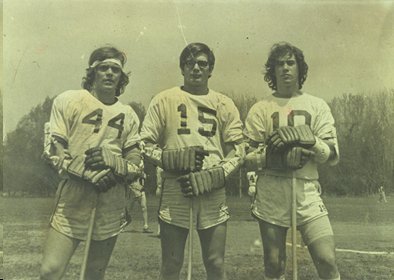
Bert Mandelbaum on right
The week he arrived, a spot opened in a graduate program at Hopkins that came with a National Institute of Health (NIH) fellowship. At the same time, he fell into a position coaching lacrosse at Hopkins. Next he went to Medical School at Washington University in St. Louis where he skipped a year because of his work at Hopkins. The lure of a Hopkins residency took him back to Baltimore where he said, “Residency was like training as a Navy seal or fighter pilot. Hard work was an understatement! I quickly transformed into the trained officer who is ready for any mission, any time, any place!”
Sports medicine and surgery had become Dr. Mandelbaum’s whole life, and as he went to UCLA for a fellowship, he felt his life was definitely on track. He served on the faculty at UCLA for four years and felt as though he’d gone to the Disneyland of Sports, because he was being exposed to the best athletes in the world there. He came to know and be inspired by UCLA legendary basketball coach John Wooden who won an unprecedented ten NCAA championships.
“One of my biggest mentors was John Wooden, starting in 1985. Every year I would take our fellows and our residents to meet him for dinner. The last time we had dinner about five years ago, he read his children’s book Inches and Miles and poetry to us. It was fantastic. He was such an icon. He had such impact on me and others”
After UCLA, Bert joined the Santa Monica Orthopedic Group (SMOG). He was considered an all-around sports doctor. “I did shoulder and elbow arthroscopies and I developed an interest in gymnastics and wrist pain. I was one of the first on the West Coast to do wrist arthroscopies. I would fix the cartilage and clean out debris and loose bodies like you do in any other joint,” he says.
Although he started off working with all body parts and became known world-wide for his work on wrists, two things happened concurrently as his career developed. The doctors in SMOG expanded and accepted fellows for training. “As we brought them in, one wanted to do the shoulder, one wanted to do the hip, one wanted to do the upper extremities, elbow, and wrist. We’ve been expanding since 1995 and now we have someone as a specialist in every one of those areas. It wasn’t about my career; it was about building the practice. It is a team sport! My research mainly focused on the knee, on articular cartilage repair, transplantation, the mechanics of why people are tearing their ACLs (anterior cruciate ligament), and prevention programs. That created a lot of interest and I was inundated with knee ligaments from all over. So now I’m type cast as a knee doctor, which is not so bad.”
As a leading sports doctor, he became the U.S. national soccer team physician and traveled to 52 countries in 18 years. Along the way, there were many intriguing international stories. Take the time the team was in Moscow during the Soviet coup in August, 1991. “We happened to be in the Kremlin when they took Gorbachev in the Russian coup. It was huge. The military was everywhere. There were probably 100,000 people in Red Square at the time. Officials whisked us off to the airport. We didn’t really know what was happening until we got to Munich. I came home and a few days later, President Reagan was in my office. He was very interested in what had happened over there. He was asking ME! He kicked the secret service out of the room and we talked for hours. Then I asked him how he related to Mikhail Gorbechev. President Reagan told me the whole story. He said he knew they were just two men. Dr. Mandelbaum next imitates Reagan’s voice saying, ‘Well, I looked in his eyes and he looked in my eyes and I knew and he knew that we wanted no part of war.’” To this day Dr. Mandelbaum keeps Ronald Reagan’s autobiography in his study signed: “To my good friend Bert, Ronnie.”
At the 1998 World Cup, the U.S. was playing Iran. No diplomatic relations existed between the two countries, but the athletes broke protocol and exchanged flowers. “There was great camaraderie between the two teams. That really speaks to the beauty of world sport and how sport can bring people together and be the gathering place for human emotions and good will. It is the Life of sport and the Sports of life.”
A story that Dr. Mandelbaum obviously cherishes spans 1986 to the year 2000. It involves Cliff Meidl, a 20-year-old kid who was in Manhattan Beach working with a jack hammer in what was supposed to be a safe area. When he contacted live electrical cables, about 30,000 volts went through him. Fast-responding fire fighters started his heart again. His legs were horribly burned and injured. Dr. Mandelbaum did fourteen surgical procedures on him over many months so that he could walk again. At that same time, Olympic gymnast Tim Daggett broke a tibia and was around the office. The two met there and Meidl took inspiration from the injured Olympian. He began paddling as a kayaker – and paddling and paddling and paddling until he made the U.S. Olympic team in kayaking in 1996 in Atlanta. The part of the story that clearly moves Dr. Mandelbaum takes place in 2000 at the Sydney Olympics. Dr. Mandelbaum is sitting in the sixth row of the opening ceremonies, which are always inspiring and uplifting all by themselves. Then the U.S. team walks in, and YES – that’s Cliff Meidl carrying the American flag at the front of the delegation! This was thirteen years after his accident and Cliff had found a way to express the athlete inside of himself, make the American Olympic team and carry the flag into the stadium.
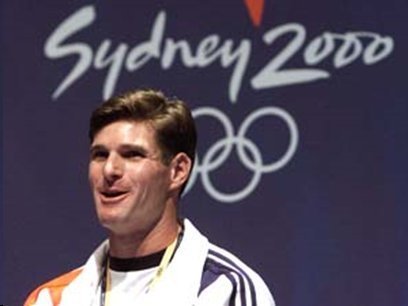
Cliff Meidl in Sydney
The next Olympic Games were in Athens in 2004. The United States was at war with Iraq. Part of Dr. Mandelbaum’s job at the time while working for FIFA (the international governing body for soccer) was to oversee the Crete venue as Medical Director. Preliminary games were played in Crete and two other Greek cities, then the finals were in Athens. Because Iraqi air space was closed due to the war, the athletes couldn’t fly out of Iraq. They drove to the Syrian border in a bus, crossed into Syria then Jordan and eventually flew from there to Greece.
“They arrive a couple of days late,” recounts Dr. Mandelbaum. “They don’t have equipment, their doctor didn’t travel with them, and I’m the FIFA medical officer who is responsible for them. They don’t have a medical kit so I’m working feverishly to get them equipment and everything they need. I was a little nervous about this whole thing – I was professional but kept my distance. Whenever they needed something, I would leave it for them at the door. So they fly in and they do really well. In fact, one night they’re playing against Australia in a preliminary round. They are the underdog. They not only came and played; they beat the Australians 2-1. By now the doctor and administrator had arrived. So after the game, it was 12:30 at night, we had to drive back to the hotel, which was about 20 miles from the stadium. We’re in one van, five Iraqis and one American, driving the dark roads of Crete and all of a sudden it must have hit them – they WON that night! The players began to sing and clap. The next thing you know, I’m clapping and singing along with them. Here we have two countries at war, five Iraqis and myself, laughing and celebrating life together. What an amazing Olympic experience.”
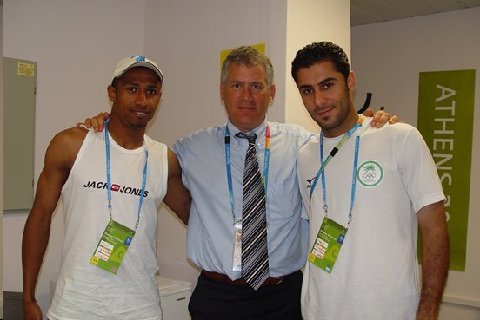
Dr. Mandelbaum with two Iraqi soccer players at the 2000 Olympics
Then there’s the story Dr. Mandelbaum speaks of as “Bubba and me.” It was the summer of 2010 and the U.S. Soccer team was at the World Cup in South Africa.
“I spent hours with President Clinton in the locker room after a game, sewing up players. He got a kick out of it. A player might need sutures on the head, and he was sitting there helping me out. We talked about everything. He wanted to talk about soccer, the team, Africa, and his new diet. He had lost 20 pounds and was talking a lot about that.”
All these remarkable stories won’t be lost. All through Dr. Mandelbaum’s career, he has made slides and taken notes in his little book. In effect, he’s become basically a medical journalist. I remember being impressed with the slides he showed in October, 1994, when he and I presented the first-ever aquatic therapy symposium in Italy. In those days, we used slides made of film rather than Powerpoint presentations.

Dr. Bert Mandelbaum on left, Lynda Huey in green
Today he has dozens of Powerpoints on his laptop that he moves easily between when wanting to make a point. That’s his raw material that has become part of his book The Win Within: Eleven Life Principles to Help You Get Off the Sidelines and Back in the Game. It will be published soon highlighting the inherent athlete in each of us.
His book came from being asked to give a graduation speech at his alma mater, the State University of New York. At the same time, he was awarded an Honorary Doctorate of Humane Letters. (The other recipient of the award was the first female four-star Army general.)
“I had to give a graduation speech to 10,000 people. I’ve spoken a lot all over the world to people and doctors, but I’d never given a graduation speech before. I started putting it together and I started writing not from the scientific part of my brain, the left brain, but from my right brain. Writing the speech motivated me so much that I started writing and writing and I just couldn’t stop writing. It was like turning on a faucet. That’s what ultimately led to my writing an inspirational, motivational book using these stories to get my eleven principles across, that life is always a great journey.”
When asked what’s the latest in research and cartilage repair, he opens another Powerpoint about Adjuvant Therapy, the concept of dealing with a complex problem in multiple layers. He explains.
“We have to think of regenerative therapies as a triad:
you need cells (dedicated cartilage cells or stem cells)
you need scaffolding (collagen-based or a composite of polylactic acid and polyglycolic acid)
you need growth factors (platelet-rich plasma, bone marrow aspirate concentrate (BMAC) or fat-derived stem cells or a combination).
Then you need to turn on the rejuvenation and at the same time turn off the degeneration. This is orthobiologics. We’re developing studies, we’re comparing, and we’re changing each of the variables looking for the best possible treatment.”
He shows a slide of a knee with a cartilage defect. “This is an example of a patient of ours having this big osteochondral (bone/cartilage) defect, and filling it with a bone graft and BMAC stem cells.” He brings up another slide. “And this is the BMAC stem cells all in a clot filling that hole. It actually clots, because you put clotting material in it and into the rest of the cartilage. There is special MRI technology to look at the repair and here you see if filling up beautifully.
“We can learn the most interesting thing about this kind of work from other fields. There have been sixteen controlled, randomized studies on patients who have had heart attacks. They injected BMAC in and around the myocardium (the muscular tissue of the heart). Six months later, the BMAC group has a better ejection fraction (how well the heart pumps each beat). The damaged tissue has been reduced significantly. But here is the most dramatic part of the study: 3 months, 6 months, and 12 months after they’ve had the heart attack and the BMAC treatment, there are these cells CD 34 and 45 that are surveillance cells. They float around the body and they say ‘we’ve had a heart attack. Send some more stem cells from the pelvis. Send some more over there. We haven’t healed enough.’ When you compare the control group that didn’t get the BMAC with the group that received it, the ones who got the BMAC have a lot more of the surveillance cells. So what’s happening is that not only is the tissue being healed locally, but enhanced healing over time is happening as well.
“That’s why when people ask if the key is this one thing or that one thing, I tell them it’s much more complicated than that. We’re interested in CD 34 being out there healing a degenerative knee, that muscle, or that tendon when you’re sleeping four months from now. The frontier is all about molecular biology and how we can utilize these techniques. Our present understanding of stem cells and maximizing their desired effect is in its infancy. It’s a good step so far.
“So even though I do mostly knees, I still have a lot of variety, because I’m always on a frontier. It never gets boring because there’s always a new concept and a new challenge to look at through clinical trials.”
Lynda Huey, M.S., founder of CompletePT Pool & Land Physical Therapy and Huey’s Athletic Network, is a former athlete and coach whose own injuries led her into the water to find fitness and healing. She was educated at San Jose State University where she starred on the track and field team during its golden years. Lynda is the author of four books on water exercise and water rehabilitation. Lynda is happy to answer the questions of any of her followers on Twitter.com/lyndahuey.
Meet Sports Orthopedic Surgeon Bert Mandelbaum, M.D.
How many doctors do you know who have spent time with U.S. Presidents? How many are so excited about sharks that they fly around the world to scuba dive with them? And how many have been official team doctors at the Olympics and the World Cup? Well, you may know some that have worked at the Games or World Cup, but sharks? And Presidents?
Let’s start with the sharks. Bert Mandelbaum, was tremendously excited about sharks in his youth, which led him to become a marine biology major at State University of New York (SUNY) in Cortland. He was a young diver then, before he started his medical career. Decades passed while he focused on building a career that has taken him around the world to the pinnacle of many sporting events such as NCAA Finals, the World Cup, and the Olympic Games. Then ten years he ago he started diving again – all over the world chasing sharks. He and his son Jordan dove with them in cages in South Africa, then in and out of cages off Guadalupe Island, 160 miles southwest of Ensenada, Mexico. “Guadalupe Island is an amazing shark habitat,” says Dr. Mandelbaum. “There are 4,000 elephant seals living there and about 200 white sharks patrol that island waiting for them to go into the water every four or five days. Sharks are the ultimate hunters – they’re amazing. I’ll show you my friends.”
Dr. Mandelbaum opens photos on his laptop to share some photos. He calls the biggest of the sharks by name. Zapata is a famous 16’ shark with a scar on his face, which makes him easy to identify. Then there’s Atlantic and Nicolas Cage. The divers go down in submersible cages into the shark habitat, but one of the cages goes down deeper to 35 feet. The video shows Dr. Mandelbaum stepping out of the cage. “There’s Zapata. He got a little close to me right there. He swam right above me. He has no interest in me,” he says coolly.
Dr. Mandelbaum’s son Jordan caught the shark fever from his dad and the two continue shark searches each year. The whole family is certified to scuba dive, so each year at Christmas time they rent a boat (captain included) in warm water and dive every day. This year it was in the Grenadines. The Mandelbaums are a family of five: wife Ruth Sorkinson, M.D. is a pediatrician; Rachel is a medical student at UCLA; Jordon attends Boston University; and Ava is in high school.
Bert Mandelbaum grew up on Long Island, N.Y. then his parents moved to Florida. Bert went to college at SUNY Cortland and lived in Long Beach, N.Y. during the summers where he worked as a beach lifeguard. “I was brought up on the ocean and competed in the lifeguard Olympics. Everything about the ocean appealed to me. The Atlantic is a simpler ocean; the Pacific is a tougher ocean. Now that I’m here, I have surfed at Topanga and Sunset, and I stand-up paddle at Paradise Cover. I just like to get out there. The beauty of living here is that there are so many different options in the water.”
Bert played lacrosse growing up, so he played at Cortland. The day he graduated, he went to visit friends in Baltimore. Johns Hopkins was the place for medicine and lacrosse, so he aimed at the two things he wanted most.
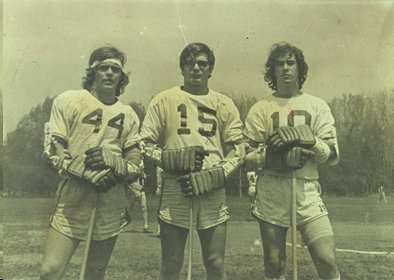
Bert Mandelbaum on right
The week he arrived, a spot opened in a graduate program at Hopkins that came with a National Institute of Health (NIH) fellowship. At the same time, he fell into a position coaching lacrosse at Hopkins. Next he went to Medical School at Washington University in St. Louis where he skipped a year because of his work at Hopkins. The lure of a Hopkins residency took him back to Baltimore where he said, “Residency was like training as a Navy seal or fighter pilot. Hard work was an understatement! I quickly transformed into the trained officer who is ready for any mission, any time, any place!”
Sports medicine and surgery had become Dr. Mandelbaum’s whole life, and as he went to UCLA for a fellowship, he felt his life was definitely on track. He served on the faculty at UCLA for four years and felt as though he’d gone to the Disneyland of Sports, because he was being exposed to the best athletes in the world there. He came to know and be inspired by UCLA legendary basketball coach John Wooden who won an unprecedented ten NCAA championships.
“One of my biggest mentors was John Wooden, starting in 1985. Every year I would take our fellows and our residents to meet him for dinner. The last time we had dinner about five years ago, he read his children’s book and poetry to us. It was fantastic. He was such an icon.”
After UCLA, Bert joined the Santa Monica Orthopedic Group (SMOG). He was considered an all-around sports doctor. “I did shoulder and elbow arthroscopies and I developed an interest in gymnastics and wrist pain. I was one of the first on the West Coast to do wrist arthroscopies. I would fix the cartilage and clean out debris and loose bodies like you do in any other joint,” he says.
Although he started off working with all body parts and became known world-wide for his work on wrists, two things happened concurrently as his career developed. The doctors in SMOG expanded and accepted fellows for training. “As we brought them in, one wanted to do the shoulder, one wanted to do the hip, one wanted to do the upper extremities, elbow, and wrist. We’ve been expanding since 1995 and now we have someone as a specialist in every one of those areas. It wasn’t about my career; it was about building the practice. My research mainly focused on the knee, on articular cartilage repair, transplantation, the mechanics of why people are tearing their ACLs (anterior crucial ligament), and prevention programs. That created a lot of interest and I was inundated with knee ligaments from all over. So now I’m type cast as a knee doctor, which is not so bad.”
As a leading sports doctor, he became the U.S. national team soccer team physician and traveled to 52 countries in 18 years. Along the way, there were many intriguing international stories. Take the time the team was in Moscow during the Soviet coup in August, 1991. “We happened to be in the Kremlin when they took Gorbachev in the Russian coup. It was huge. The military was everywhere. There were probably 100,000 people in Red Square at the time. Officials whisked us off to the airport. We didn’t really know what was happening until we got to Munich. I came home and a few days later, President Reagan was in my office. He was very interested in what had happened over there. He was asking ME! He kicked the secret service out of the room and we talked for hours. Then I asked him how he related to Mikhail Gorbechev. President Reagan told me the whole story. He said he knew they were just two men. Dr. Mandelbaum next imitates Reagan’s voice saying, ‘Well, I looked in his eyes and he looked in my eyes and I knew and he knew that we wanted no part of war.’” To this day Dr. Mandelbaum keeps Ronald Reagan’s autobiography in his study signed: “To my good friend Bert, Ronnie.”
At the 1998 World Cup, the U.S. was playing Iran. No diplomatic relations existed between the two countries, but the athletes broke protocol and exchanged flowers. “There was great camaraderie between the two teams. That really speaks to the beauty of world sport and how sport can bring people together and be the gathering place for human emotions and good will.”
A story that Dr. Mandelbaum obviously cherishes spans 1986 to the year 2000. It involves Cliff Meidl, a 20-year-old kid who was in Manhattan Beach working with a jack hammer in what was supposed to be a safe area. When he contacted live electrical cables, about 30,000 volts went through him. Fast-responding fire fighters started his heart again. His legs were horribly burned and injured. Dr. Mandelbaum did fourteen surgical procedures on him over many months so that he could walk again. At that same time, Olympic gymnast Tim Daggett broke a tibia and was around the office. The two met there and Meidl took inspiration from the injured Olympian. He began paddling as a kayaker – and paddling and paddling and paddling until he made the U.S. Olympic team in kayaking in 1996 in Atlanta. The part of the story that clearly moves Dr. Mandelbaum takes place in 2000 at the Sydney Olympics. He’s sitting in the sixth row of the opening ceremonies, which are always inspiring and uplifting all by themselves. Then the U.S. team walks in, and YES – that’s Cliff Meidl carrying in the American flag at the front of the delegation! This was thirteen years after his accident and Cliff had found a way to express the athlete inside of himself, make the American Olympic team and carry the flag into the stadium.
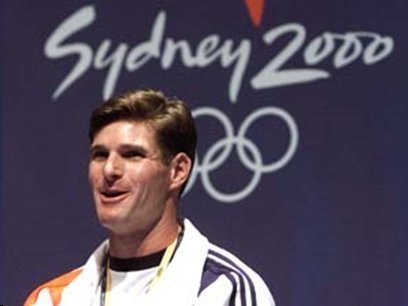
Cliff Meidl in Sydney
The next Olympic Games were in Athens in 2004. We were at war with Iraq. Part of Dr. Mandelbaum’s job at the time while working for FIFA (the international governing body for soccer) was to oversee the Crete venue as Medical Director. Preliminary games were played in Crete and two other Greek cities, then the finals were in Athens. Because Iraqi air space was closed due to the war, the athletes couldn’t fly out of Iraq. They drove to the Syrian border in a bus, crossed into Syria then Jordan and eventually flew from there to Greece. “They arrive a couple of days late,” recounts Dr. Mandelbaum. “They don’t have equipment, their doctor didn’t travel with them, and I’m the FIFA medical officer who is responsible for them. They don’t have a medical kit so I’m working feverishly to get them equipment and everything they need. I was a little nervous about this whole thing – I was professional but kept my distance. Whenever they needed something, I would leave it for them at the door. So they fly in and they do really well. In fact, one night they’re playing against Australia in a preliminary round. They are the underdog. They not only came and played; they beat the Australians 2-1. By now the doctor and administrator had arrived. So after the game, it was 12:30 at night, we had to drive back to the hotel, which was about 20 miles from the stadium. We’re in one van, five Iraqis and one American, driving the dark roads of Crete and all of a sudden it must have hit them – they WON that night! The players began to sing and clap. The next thing you know, I’m clapping and singing along with them. Here we have two countries at war, five Iraqis and myself, laughing and celebrating life together. What an amazing experience.”
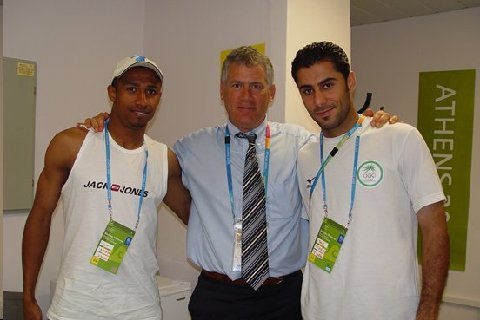
Dr. Mandelbaum with two Iraqi soccer players at the 2000 Olympics
Then there’s the story Dr. Mandelbaum speaks of as “Bubba and me.” It was the summer of 2010 and the U.S. Soccer team was at the World Cup in South Africa.
“I spent hours with President Clinton in the locker room after a game, sewing up players. He got a kick out of it. A player might need sutures on the head, and he was sitting there helping me out. We talked about everything. He wanted to talk about soccer, the team, and Africa and his new diet. He had lost 20 pounds and was talking a lot about that.”
All these remarkable stories won’t be lost. All through Dr. Mandelbaum’s career, he has made slides and taken notes in his little book. In effect, he’s become basically a medical journalist. I remember being impressed with the slides he showed in October, 1994 when he and I presented the first-ever aquatic therapy symposium in Italy. In those days, we used slides made of film rather than Powerpoint presentations.

Dr. Bert Mandelbaum on left, Lynda Huey in green
Today he has dozens of Powerpoints on his laptop that he moves easily between when wanting to make a point. That’s his raw material that has become part of his book The Win Within: Eleven Life Principles to Help You Get Off the Sidelines and Back in the Game. It will be published soon highlighting the inherent athlete in each of us.
His book came from being asked to give a graduation speech at his alma mater, the State University of New York. At the same time, he was awarded an Honorary Doctorate of Humane Letters. (The other recipient of the award was the first female four-star Army general.) “I had to give a graduation speech to 10,000 people. I’ve spoken a lot all over the world to people and doctors, but I’d never given a graduation speech before. I started putting it together and I started writing not from the scientific part of my brain, the left brain, but from my right brain. Writing the speech motivated me so much that I started writing and writing and I just couldn’t stop writing. It was like turning on a faucet. That’s what ultimately led to my writing an inspirational, motivational book using these stories to get my eleven principles across, that life is always a great journey.”
When asked what’s the latest in research and cartilage repair, he opens another Powerpoint about Adjuvant Therapy, the concept of dealing with a complex problem in multiple layers.
“We have to think of regenerative therapies as a triad:
1) you need cells (dedicated cartilage cells or stem cells)
2) you need scaffolding (collagen-based or a composite of polylactic acid and polyglycolic acid)
3) you need growth factors (platelet-rich plasma, bone marrow aspirate concentrate (BMAC) or fat-derived stem cells or a combination).
This is orthobiologics. We’re developing studies, we’re comparing, and we’re changing each of the variables looking for the best possible treatment.”
He shows a slide of a knee with a cartilage defect. “This is an example of a patient of ours having this big osteochondral (bone/cartilage) defect, and filling it with a bone graft and BMAC stem cells.” He brings up another slide. “And this is the BMAC stem cells all in a clot filling that hole. It actually clots, because you put clotting material in it and into the rest of the cartilage. There is special MRI technology to look at the repair and here you see if filling up beautifully.
“We can learn the most interesting thing about this kind of work from other fields. There have been sixteen controlled, randomized studies on patients who have had heart attacks. They injected BMAC in and around the myocardium (the muscular tissue of the heart). Six months later, the BMAC group has a better ejection fraction (how well the heart pumps each beat). The damaged tissue has been reduced significantly. But here is the most dramatic part of the study: 3 months, 6 months, and 12 months after they’ve had the heart attack and the BMAC treatment, there are these cells CD 34 and 45 that are surveillance cells. They float around the body and they say ‘we’ve had a heart attack. Send some more stem cells from the pelvis. Send some more over there. We haven’t healed enough.’ When you compare the control group that didn’t get the BMAC with the group that received it, the ones who got the BMAC have a lot more of the surveillance cells. So what’s happening is that not only is the tissue being healed locally, but enhanced healing over time is happening as well.
“That’s why when people ask if the key is this one thing or that one thing, I tell them it’s much more complicated than that. We’re interested in CD 34 being out there healing a degenerative knee, that muscle, or that tendon when you’re sleeping four months from now. The frontier is all about molecular biology and how we can utilize these techniques. Our present understanding of stem cells and maximizing their desired effect is in its infancy. It’s a good step so far.
“So even though I do mostly knees, I still have a lot of variety, because I’m always on a frontier. It never gets boring because there’s always a new concept and a new challenge to look at through clinical trials.”
Lynda Huey, M.S., founder of CompletePT Pool & Land Physical Therapy and Huey’s Athletic Network, is a former athlete and coach whose own injuries led her into the water to find fitness and healing. She was educated at San Jose State University where she starred on the track and field team during its golden years. Lynda is the author of four books on water exercise and water rehabilitation. Lynda is happy to answer the questions of any of her followers on Twitter.com/lyndahuey.


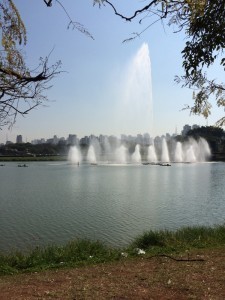
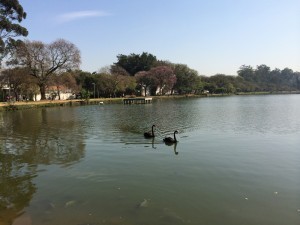
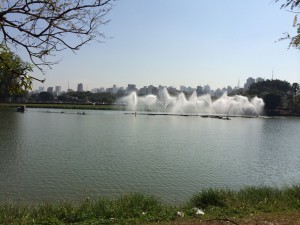
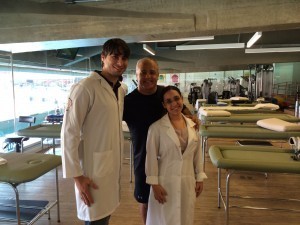
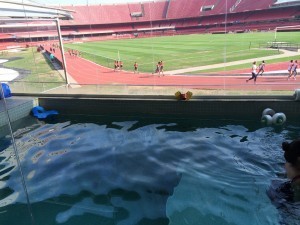
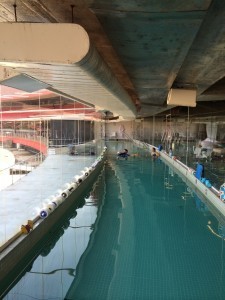





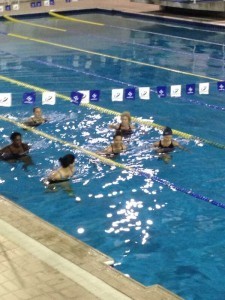
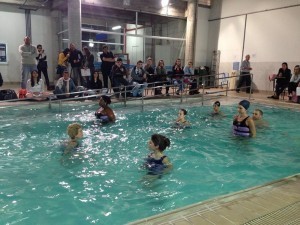
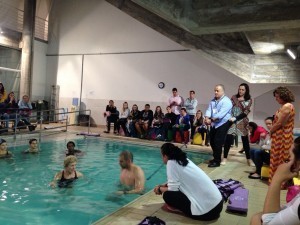
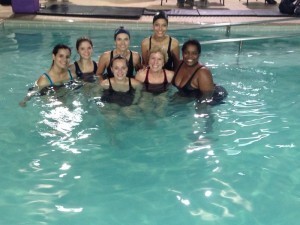

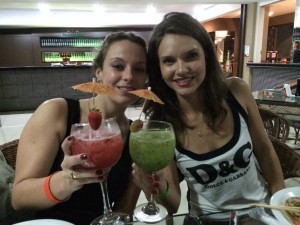
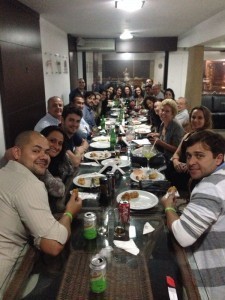

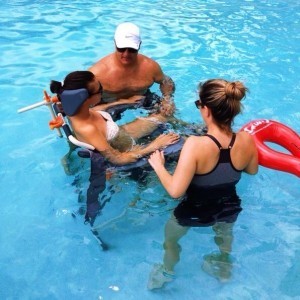
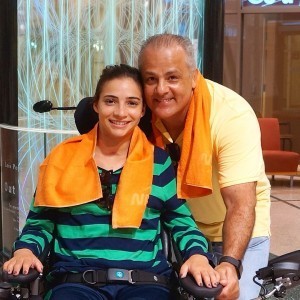




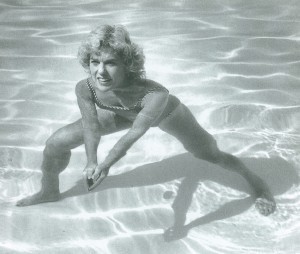






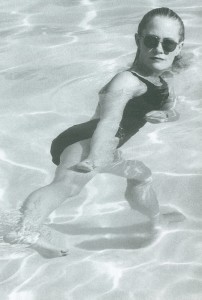
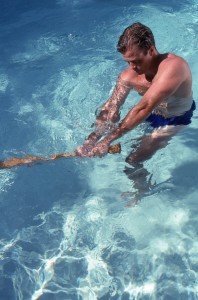 .
.